Member Blog: California’s Gold Standard – Navigating Cannabis Testing Regulations

By Harrison Bard, Co-Founder and CEO, Custom Cones USA
Understanding California’s Regulatory Landscape & Comprehensive Testing Requirements
While every state has its own testing requirements for the cannabis industry, few markets require more than California, which has been on the leading edge of cannabis testing and regulation since voters approved the state’s recreational market.
In the Golden State, all cannabis products must be tested by a licensed laboratory in their final form, or how the product will be sold to customers at retail, not just the flower. That means that not only does your flower have to be clean, but so does all of your other ingredients or components, since anything can trigger a failure, including the paper in your pre-rolls.
Testing Parameters: Ensuring Safety
Both flower and pre-rolls, for example, must be tested for:
- Moisture Content and water activity;
- Residual solvents and processing chemicals;
- Residual pesticides;
- Microbial impurities;
- Mycotoxins;
- Foreign materials;
- The “big four” heavy metals (arsenic, cadmium, lead and mercury);
- Cannabinoids; and
- Terpenes (if requested).
Almost all of these tests get at a safety issue.
Moisture content and water activity, for example, relate to mold growth. Water activity is a measure of the percentage of water in your cannabis product. In California, a cannabis sample cannot have a water activity of more than 0.65 Aw (or 0.85 Aw for solid edible products). This is because anything above 0.70 Aw creates the conditions for mold to grow, which can be dangerous if consumed.
Addressing Safety Concerns: Mycotoxins and Pesticides
Mycotoxins are also a safety issue. Mycotoxins are a toxic compound produced by molds, such as Aspergillus, and can damage the liver and even suppress the immune system. The two classes of mycotoxins that California requires testing for, Aflatoxins and Ochratoxins, have properties that can alter our DNA and even spur the formation of cancer cells. Mycotoxin testing ensures that products are safe for human consumption and inhalation. In California, samples may not exceed 20 micrograms of either aflatoxins and ochratoxins.
Like many states California also requires testing for residual pesticides, including 21 “Category I” chemicals that are not allowed in any amount and 45 “Category II” chemicals that include “action levels” that the sample may not exceed. These chemicals can be very harmful to humans, causing damage to organs and other long-term health issues.
The state provides a list of acceptable pesticides through its Department of Pesticide Regulation website.
The state also requires testing for the heavy metals mercury, cadmium, lead and arsenic. All four of those metals are toxic to humans, even at small doses, and can damage all the body’s vital systems, including pulmonary, reproductive and even the central nervous system. For inhalable products, the state sets the pass/fail actionable level at 0.1 micrograms for mercury, 0.2 micrograms for arsenic and cadmium and 0.5 micrograms for lead.
These tests for heavy metals are especially important because cannabis plants are a well-known bio-accumulator that absorbs and collects heavy metals from the soil in which it grows.
Regulatory Updates and Standardization
In 2024, California also created standardized operating procedures and test methods for testing cannabis flower and pre-rolls and requires all of its licensed laboratories to use the new SOPs to ensure testing is consistent across the state.
Key Considerations for Manufacturers: Paper Suppliers
But one of the keys to California’s regulations is the need to test all products in their final form, which means that not only does your flower have to pass all tests, but every other part of your product as well. For pre-rolls, this includes your rolling papers and cones. And there have been instances of the papers causing batches of products to fail testing.
There are also examples of rolling papers that, when tested on their own, have actionable levels of heavy metals or pesticides, for example.
Ensuring Compliance: Pre-Roll Manufacturers Beware
SC Labs, one of California’s licensed testing labs, found that 11% of rolling papers tested during a recent study would fail testing. The lab purchased 118 products from Amazon and several smoke shops in the Santa Cruz area. Its scientists tested 101 for heavy metals and 112 for pesticide contamination. At least one heavy metal was detected in 90% of the rolling paper products with 8% containing at least one heavy metal in concentrations above the allowable limits. Pesticides were detected in 16% of the samples with 5% coming in over the allowable action limits.
Because of this, pre-roll manufacturers need to be especially careful in their choice of paper supplier to ensure that the cones you pack your pre-rolls in don’t cause an entire batch of product to need to be destroyed, or worse.
Expert Insights and Recommendations
“Take due diligence to make sure your product is viable. Any one issue can be detrimental to your brand reputation,” says André Bayard, Compliance Manager at Custom Cones USA.
Bayard says it’s important to find a pre-roll supplier that focuses on testing and compliance and can provide a Certificate of Analysis to back up its products so your finished pre-rolls are as clean as the flower you put in them.
“In highly regulated markets, work with a company that focuses on those requirements and are trying to set the industry standard with their products,” Bayard says.
Conclusion: Upholding Standards
A testing failure can be cumbersome and costly, especially for smaller businesses, and can follow a company and its products even after the issue is corrected. You put a lot of care and effort into growing the best cannabis you can, so make sure your pre-roll supplier does too.
Join Us for More Exclusive Insights on California Marketplace
Striving to stay informed about California’s dynamic cannabis industry? We’re thrilled to invite you to two exciting NCIA events tailored for California’s vibrant cannabis industry. Mark your calendars for our upcoming California Stakeholder Summit being held in Sacramento, CA on Thursday, February 22nd and the California-focused edition of our Policy Matters webinar series being broadcast on Thursday, February 8th.
• California Stakeholder Summit 2024: Dive deep into the latest trends, regulations, and opportunities shaping California’s cannabis landscape. Join featured speakers United States Representative Congresswoman Barbara Lee (D-Oakland), Director of California Department of Cannabis Control, Nicole Elliot, and California Assembly Majority Leader Cecilia Aguiar-Curry (D-Winters). All industry professionals are invited; NCIA members attend free and have exclusive access to participate in the Q&A session. Register here to secure your spot.

• Policy Matters: Golden State Green – Regulating California’s Cannabis Industry: Join us for an insightful discussion on the evolving policies and regulations impacting California’s cannabis sector. Gain valuable insights from experts and thought leaders driving change in the Golden State. Register now to reserve your virtual seat.

Don’t miss out on these invaluable opportunities to stay informed, network, and shape the future of cannabis in California. Register today and be part of the conversation!
Member Blog: Cannabis Convenience – Exploring the Rise of Delivery Services in Local Markets

by Erika Cruz, Outreach Monks
Remember the long lines and awkward whispers at the dispensary? Those days are fading faster than you can say “indica.” Cannabis delivery services are popping up around the corner, delivering your favorite flower, edibles, and more right to your door. This boom isn’t just about convenience, though. It’s about changing laws, new technology, and a growing desire for discreet, easy access to cannabis.
What’s particularly intriguing is the role of legislation in shaping this landscape. For instance, California voters approved Prop 64 or the Adult Use of Marijuana Act, allowing adults 21 yrs or more to legally grow, possess, and use cannabis for non-medical purposes. This state act not only welcomed statewide legalization but also allowed its 58 counties, including the city of Sacramento, the autonomy to develop their policies and regulations around cannabis retail, manufacturing, and cultivation. This decentralized approach has been instrumental in fostering the growth and diversity of California’s cannabis market, setting the stage for the rise of innovative delivery services.
So, what’s driving this surge in cannabis delivery service? In this article, we’ll dive into this question and discover how delivery services are not just changing the face of cannabis retail but also influencing consumer behavior and nurturing a sense of community among cannabis enthusiasts.
What is Cannabis E-commerce?
Cannabis e-commerce refers to the online retailing of cannabis products. This type of e-commerce operates within the legal frameworks of regions where cannabis is legally permitted for medicinal or recreational use. It involves various products derived from the cannabis plant, such as dried flowers, oils, edibles, and other related merchandise.
In cannabis e-commerce, consumers typically browse an online platform or website that lists available cannabis products. These platforms provide product descriptions, potency levels, usage instructions, and pricing information. Consumers can select products, add them to a virtual cart, and purchase online. The purchased items are then delivered to the consumer’s location, subject to legal regulations regarding delivery and distribution.
But if you are not sure which cannabis seller to trust, look for a seller who prioritizes safe, reliable, and convenient access to a diverse selection of cannabis products. For instance, Nexus Delivers in Sacramento is a notable choice to explore. Their dedication to quality, safety, and variety sets them apart as a trusted option in cannabis e-commerce.
Driving Forces Behind the Rise of Cannabis Delivery
1. Convenience and Discretion
Cannabis delivery brings your order discreetly to your door, on your schedule. Perfect for busy bees or privacy seekers, it’s the hassle-free high you crave. No crowds, no awkward stares, just pure convenience and the freedom to enjoy at your own pace.
Plus, discreet packaging and secure payment methods are essential components of this aspect. It involves ensuring that all transactions and deliveries are conducted with the utmost confidentiality, protecting consumers’ privacy.
2. Enhanced Product Selection and Information
Online platforms boast wider product selections compared to local dispensaries, often presenting detailed descriptions, reviews, and educational resources. This empowers consumers to make informed choices, discover new strains and products, and compare prices with transparency.
So, blast off from the dispensary doldrums and dive into the boundless knowledge and options offered by delivery – your perfect bud awaits.
3. Accessibility and Inclusivity
Accessibility means that consumers, regardless of their location, can easily browse and purchase cannabis products online. It breaks down geographical barriers, enabling those in remote areas or with limited mobility to access the benefits of cannabis.
Inclusivity goes beyond geographical access and emphasizes catering to a diverse clientele. It involves offering a range of products to suit various preferences and needs, including those seeking medicinal benefits. This means sellers can reach a broader audience and sell more.
4. Competition and Market Expansion
Delivery services play a pivotal role in fostering competition and driving market expansion in the cannabis industry. They act as catalysts, sparking a cycle of benefits for both businesses and consumers. By offering convenient and efficient delivery options, dispensaries are compelled to compete vigorously.
This competition has a twofold effect. Firstly, it exerts pressure on prices, forcing dispensaries to lower their rates to remain competitive. Secondly, it incentivizes dispensaries to enhance the quality of their cannabis products and elevate their customer service standards. As a result, consumers enjoy more affordable options, a wider array of top-notch products, and superior service.
Data and Marketing Opportunities
Delivery platforms gather valuable data on user preferences and consumption patterns, enabling targeted marketing and product development. This information forms the foundation for targeted marketing strategies. Dispensaries can personalize customer experiences, offering tailored product recommendations that align with individual tastes and needs.
Additionally, businesses can identify specific demographics and market segments, allowing them to effectively develop and fine-tune their product offerings to cater to these diverse groups.
Evolving Regulatory Landscape
Legitimate and licensed delivery services are emerging, and this transformation is creating a safer and more accountable cannabis industry.
These licensed delivery services play a crucial role in addressing various concerns. They prioritize safety by implementing robust age verification procedures, ensuring that only adults have access to cannabis products. Additionally, these services are actively involved in educational initiatives, promoting responsible consumption.
Conclusion
Remember, it’s not just about avoiding awkward stares at the dispensary; it’s about unlocking a universe of options from your couch. As this market blossoms, let’s keep it chill, responsible, and full of delicious possibilities. After all, who wouldn’t want a world where bud travels to you?
We appreciate your interest and hope you found this article valuable.
The Cannabis Risk Management Series: Cannabis Risk in Retail – The Thorny Issue of Theft Claims

Welcome back to the second chapter of our insightful Cannabis Risk Management series from Valerie Taylor with NCIA Blooming Member The Liberty Company Insurance Brokers. In our inaugural blog, we meticulously examined the art and science of cannabis cultivation, dissecting the unique risks and unveiling strategies to safeguard your valuable assets. Now, our expedition leads us to the dynamic retail sector, where the shadows of theft claims cast a challenging hue on the landscape.
The Nuances of Cannabis Retail Risk
Cannabis retail, often hailed as the face of the cannabis industry, pulsates with its own set of challenges, and at the forefront is the persistent threat of theft claims. In this segment, we delve deep into the intricate risks associated with cannabis retail, emphasizing the need for a robust risk management strategy.
1. Theft Beyond Products: Safeguarding Operational Vitality
While the theft of cash and actual cannabis products remains a primary concern, the spotlight extends to the vulnerability of operational assets. Tangible tenant improvements (displays, lighting, vault, and security systems), and other essential equipment, constitute not just commodities, but the operational pulse of a cannabis retail space. The financial ramifications of losing such assets extend beyond the immediate value of the stolen item, potentially disrupting the entire business operation.
2. Security Measures: Beyond Conventional Safeguards
Protecting against theft demands a proactive stance that transcends traditional security measures. To fortify your retail space, embracing cutting-edge technologies becomes imperative. Smart safes, equipped with biometric access and RFID tagging for inventory offer significant theft deterrence of cash. In general, they can contribute to a seamless inventory management system, minimizing the impact of potential theft incidents.
3. Advanced Surveillance Systems: The Eyes and Ears of Security
Enhancing security measures involves a comprehensive approach, and advanced surveillance systems play a pivotal role. Beyond conventional CCTV, modern systems with facial recognition, real-time monitoring, and integrated analytics provide a more sophisticated layer of defense. These technologies not only deter theft but also offer valuable insights for ongoing risk management.
Mitigating Theft Risks in Cannabis Retail
1. Community Engagement and Public Awareness: Forging Collective Vigilance
Effective theft prevention extends beyond the physical boundaries of the store; it involves creating a community-driven shield against potential threats. Establishing strong bonds with the local community can serve as a natural deterrent. Positive relationships and community engagement foster a sense of shared responsibility for the safety of the retail space, creating a formidable barrier against potential thieves.
2. Employee Training and Incentives: Fortifying the Front Lines
Empowering your staff with the skills and knowledge to identify and prevent theft is a cornerstone in fortifying your retail space. Implementing comprehensive training programs that educate employees on recognizing suspicious behavior, coupled with incentives for maintaining a secure environment, forms a powerful defense strategy against theft.
3. Insurance Tailored to Retail Risks: Beyond Standard Coverage
While standard insurance policies offer a foundational level of coverage, the dynamic nature of cannabis retail necessitates a bespoke approach. Collaborating with a seasoned insurance advisor specializing in cannabis is not just advisable, but paramount. A tailored insurance policy for retail should go beyond protecting the products; it should encompass the essential equipment components for daily operations, ensuring a comprehensive shield against potential financial losses.
4. Data-Driven Risk Analysis: Navigating the Digital Landscape
Harnessing the power of data is a crucial aspect of modern risk management. Utilizing data analytics and monitoring tools allows retailers to identify patterns, potential vulnerabilities, and areas of improvement in their security infrastructure. This data-driven approach not only aids in theft prevention but also enhances overall operational efficiency.
As we prepare for our next exploration into the distribution sector, where we’ll unravel the complexities of risks involving theft, auto incidents, and more, I encourage you to delve deep into the intricacies of cannabis risk in retail. Stay tuned for a wealth of insights and strategies to navigate the multifaceted challenges at every stage of your cannabis business journey.
For more information, please reach out to Valerie Taylor, Vice President (National Cannabis Practice Leader), Liberty Company Insurance Brokers.
Member Blog: Cannabis Industry Predictions for 2024

Presented by the Cannabis Team with BGM, a Seedling Member of NCIA
As we usher in the transformative year of 2024, the cannabis industry stands at the threshold of unprecedented growth and evolution. The Cannabis Team at BGM, a dedicated Seedling Member of the National Cannabis Industry Association (NCIA), invites you to explore the latest insights and predictions for the cannabis sector in their comprehensive blog post. This overview provides a glimpse into the changing landscape, legislative shifts, emerging market dynamics, and the multitude of opportunities and challenges that lie ahead.
Let’s look at the latest insights and 2024 predictions for the cannabis industry. This blog addresses the changing landscape, including regulatory shifts and market opportunities. Continue reading to explore the future of the cannabis industry and learn how your cannabis business can stay ahead in the coming year.
Growth and Expansion
In 2024, the global cannabis market is expected to experience substantial growth, fueled by emerging legal markets, innovative product offerings, and technological advancements. This growth presents opportunities and challenges, especially in navigating complex legal and regulatory landscapes.
Market Dynamics
- Projected Market Growth: The U.S. cannabis market is projected to grow significantly. Retail cannabis sales could reach $53.5 billion by 2027, with adult-use sales growing more rapidly. States like New York are working on finalizing details to launch approved programs, contributing to this growth.
- Technological Advancements: Blockchain and AI will likely revolutionize supply chain management and compliance tracking.
- Product Innovation: The trend toward personalized cannabis products is expected to gain traction as consumers become more educated and discerning. Cannabis companies will likely continue tailoring their products to meet a wide range of individual needs and preferences. However, pre-rolls are projected to continue to be a top product sale item in 2024. As people progress in their exploration and knowledge of cannabis, we believe they will gravitate towards craft cannabis products, and artisanal flower, despite the enduring demand for low-cost and convenient options.
Legislative Predictions
- Legalization: We foresee several additional states legalizing recreational cannabis in 2024. Federal legalization of medical or recreational cannabis appears to be a long way off, as demonstrated by the inability of the SAFE Banking Act to pass in Congress.
- SAFE Banking Act: This continues to be a pivotal issue, with potential movement expected in 2024.
- Federal Rescheduling: Anticipated action by President Biden could reshape the industry’s regulatory framework, impacting financial reporting and taxation.
- State-Level Changes: States like Maryland, possibly followed by Pennsylvania and Ohio, may influence regional market dynamics and tax structures.
Industry Trends
- Ancillary Services: As the industry grows, so does the demand for financial and ancillary services, highlighting the need for specialized accounting solutions and advisory services.
- Canadian Market Resurgence: Canadian cannabis stocks may witness a revival, affecting cross-border financial transactions and investment strategies.
- Global Influence: Germany’s role as a market catalyst emphasizes the importance of understanding international financial regulations in the cannabis sector.
State Trends
- Maryland and Neighboring States: Maryland’s recent move to full legalization is expected to influence neighboring states. Analysts predict that Pennsylvania might follow Maryland’s lead. There’s also pressure on Virginia to get its program operational in 2024.
- Vermont and Mississippi: Farmers in states such as Vermont and Mississippi, which have legalized cannabis, face challenges with federal regulations around hemp cultivation. The U.S. Department of Agriculture (USDA) has rescinded hemp licenses for some farmers who grow marijuana, reflecting the ongoing conflict between federal and state laws regarding cannabis.
- New York: The New York Cannabis Control Board anticipates approving additional licenses in early 2024. We will wait to see the progress.
- Continued Legalization Trends: More states are likely to embrace broader cannabis legalization, including CBD and Delta 8 THC, enhancing consumer accessibility across the U.S. This trend is driven by legal advancements, ongoing research, and shifting societal views.
To continue reading the full article and explore the remaining sections on Financial Implications, Technology and Data Management, Ethical and Social Considerations, Global Market Integration, and Risk Management, click here to visit BGM’s website. Your journey into the future of cannabis begins now.
Join the Cannabis Movement: Become an NCIA Member Today
As we delve into the transformative year of 2024 in the cannabis industry, it’s crucial to be part of a community that champions growth, innovation, and advocacy. The National Cannabis Industry Association (NCIA) stands at the forefront, shaping the future of the cannabis sector.
Why Join NCIA?
- Network with Industry Leaders: Connect with like-minded professionals, industry leaders, and visionaries who are driving the cannabis industry forward. NCIA offers a platform for networking and collaboration that is unparalleled.
- Stay Informed: Stay ahead of the curve with the latest insights, trends, and legislative updates. NCIA provides valuable resources and information, ensuring that you are well-informed about the dynamic landscape of the cannabis market.
- Advocacy and Influence: Be part of a collective voice that advocates for sensible cannabis policies at the national level. As a member of NCIA, you contribute to shaping the regulatory environment and fostering a thriving, responsible cannabis industry.
Who Should Join?
If you are a cannabis business owner, entrepreneur, investor, or industry enthusiast, NCIA is your gateway to a community that understands the unique challenges and opportunities within the cannabis sector. Whether you’re navigating legislative changes, seeking business connections, or staying informed about market dynamics, NCIA is the ultimate resource.
How to Join:
Becoming an NCIA member is simple. Visit our membership page to explore the benefits and choose the membership level that aligns with your goals. Join the community that is actively shaping the future of the cannabis industry.
Member Blog: Discovering Dank – Unraveling the Mystery of the Cannabis Plant’s Iconic Odor
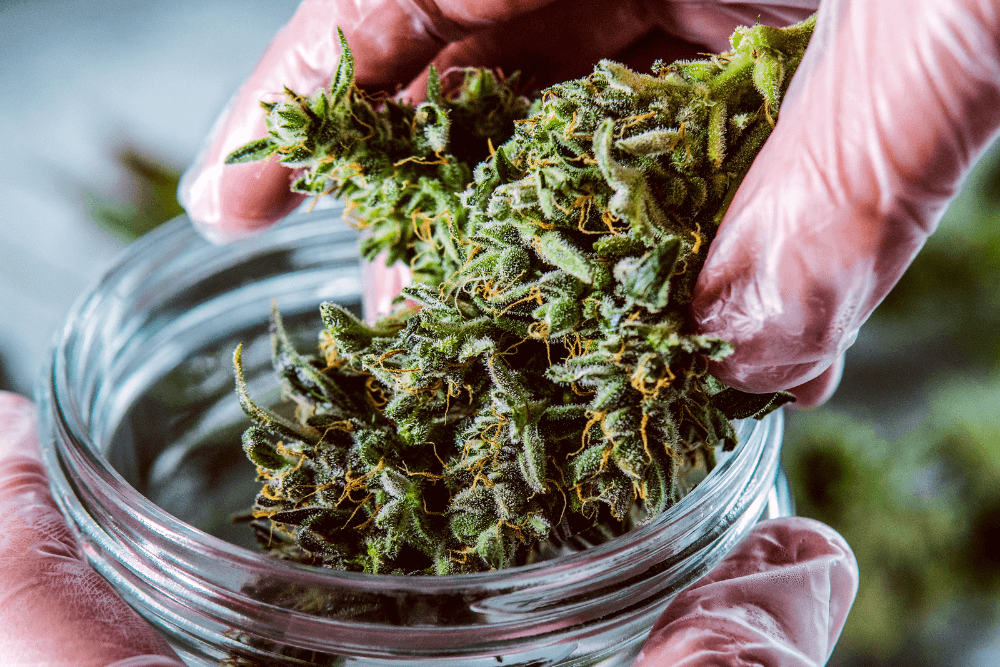
For decades, cannabis enthusiasts and scientists alike have been intrigued by the distinctive scents emitted by various cannabis cultivars. Particularly, the question that has persisted among many is: which compounds are responsible for the potent gassy and skunky scents so often associated with cannabis?
Abstrax Tech, a frontrunner in cannabis research, has recently made headway in answering this question. Their innovative research, encompassing advanced techniques and collaborative efforts, has brought forward the discovery of an entirely new class of aromatics, Cannasulfur Compounds (CSCs). These compounds, as discussed in Abstrax Tech’s white paper, “The Science of Dank” are the key to understanding the much-debated gassy aroma of cannabis.
The Path to Discovery
To delve deep into the scent mysteries, Abstrax Tech combined advanced Gas Chromatography (GC x GC) with various detectors, allowing for a nuanced detection of compounds. Their collaboration with acclaimed cannabis growers, like Mario Guzman of Sherbinskis and Josh Del Rosso (the original breeder of OG Kush), equipped them with diverse cannabis samples to analyze.
The analytical journey led the Abstrax team to an exciting hypothesis. What if the gassy scent in cannabis is sulfur-based? The team noticed the common occurrence of sulfur compounds in other potently aromatic foods, such as durian and garlic. Validating this hunch, they detected significant correlations between the presence of sulfur compounds and the skunky scent across various cultivars.
Among the discovered compounds, one was identified as 3-methyl-2-butene-thiol or “prenyl thiol”, with others also containing the same functional group, the “prenyl” group. Subsequent chemical synthesis and testing confirmed their role in producing the characteristic scent of cannabis.
The Significance of Timing in Cannabis Growth
But it’s not just about identifying the compounds. Abstrax Tech further explored when these aromatic CSCs are produced during cannabis growth. Their findings were eye-opening. The CSC concentrations skyrocket towards the end of the growth cycle and peak during the curing process, only to decrease rapidly post-harvest. This discovery holds immense value for growers, emphasizing the criticality of timing and packaging to retain the prized scent for consumers.
Cannasulfur Compounds in Cannabis Extracts
Cannabis extracts, popularly consumed in various forms, also raised the question: Do these volatile CSCs survive the extraction process? The answer, as per experiments, is a resounding yes, but with a caveat. The extraction process has to be meticulously executed. Techniques involving cryogenic extraction and minimal heat post-processing proved successful in preserving these aromatic compounds. Meaning that, just like terpenes, heat and oxygen will cause degradation.
Benefits for Cannabis Vape Manufacturers:
For cannabis vape manufacturers, CSCs represent a monumental advancement in the quest for genuine cannabis experiences:
- Authentic Flavor Profiles: CSCs can be integrated into vape cartridges, recreating the unique aromatic and flavor profile of cannabis but in a botanical (and legal) format.
- Product Differentiation: Emphasizing the presence of these natural compounds can distinguish a brand in a crowded market.
- Precise Flavor Replication: With CSCs, manufacturers can precisely replicate specific strain aromas.
- Enhanced User Experience: Experienced consumers will get a more accurate cannabis flavor and aroma experience.
- Consistency from Batch to Batch: Using CSCs ensures every user gets a similar authentic experience, batch after batch.
Conclusion
Abstrax Tech’s groundbreaking discovery of Cannasulfur Compounds in cannabis is a testament to the endless surprises the plant holds. While the quest to identify the compounds behind the iconic gassy aroma has found its answer, it’s clear that this is just the tip of the iceberg for cannabis research. With each revelation, cannabis continues to unveil its vast potential, promising a future of exciting research and discoveries.
Ready to dive deeper into the fascinating world of cannabis discoveries?
Join the National Cannabis Industry Association (NCIA) and connect with like-minded enthusiasts, researchers, and industry professionals. As an NCIA member, you’ll stay on the cutting edge of groundbreaking findings, just like Abstrax Tech’s exploration into Cannasulfur Compounds. Don’t miss out – click here to join NCIA now and be part of the thriving cannabis community shaping the future of the industry.
Elevate Your Dispensary’s Presence In 2024 Using These Promotion Tricks

As we step into 2024, it’s safe to say that the cannabis industry is not just growing; it’s thriving! The reports reveal that the number of medical marijuana dispensaries in the US has observed a 1.7% jump from the previous year- totaling 5,142 in 2022.
Moreover, the industry is expected to skyrocket, with a projected compound annual growth rate (CAGR) of 14.66% from 2023 to 2028, reaching a market value of US$67.15 billion by 2028. Isn’t that amazing?
In such a booming market, the potential to earn profits is enormous. But how can you capitalize on this opportunity and make your dispensary the go-to place for cannabis products?
Are you also wondering the same? If so, we’ve got you covered! We have compiled a list of effective promotion tricks to help you elevate your dispensary in 2024. Let’s explore them together!
Focus On Local SEO To Maximize Your Visibility
Have you ever noticed that some dispensaries seem to have a never-ending stream of customers while others struggle for the same despite offering similar products and services?
If yes, the reason for such a difference is the savvy use of Local SEO. According to statistics, 46% of people search for local businesses on Google. What’s even more surprising is that around 80% of these local searches result in conversion.
Let’s take a look at this using an example. Suppose you own a dispensary in Buchanan, MI. In that case, if you want your buchanan dispensary to be the talk of the town, you must focus on Local Search Engine Optimization. This includes several steps, and a few of them are given below:
- Ensure your Google My Business (GMB) profile is complete and accurate. It includes up-to-date contact details, operating hours, and high-quality images.
- Use relevant keywords in your business description, focusing on terms potential customers might use. For instance, “Dispensary in [Your City] such as Buchanan, MI.”
- Create localized and reader-friendly content on your website, such as blog posts about community events or local cannabis news.
- Have a mobile-friendly website, as most local searches are done on mobile devices.
- Build local backlinks by collaborating with other local businesses and participating in community events. It will boost your local search rankings.
Provide Exclusive Deals On The Home Page
After fine-tuning your local SEO, your website homepage becomes a vital touchpoint for capturing visitor interest. Picture this: a potential customer, drawn in by your high search ranking, lands on your site and gets greeted with an offer they can’t resist. That’s the power of providing exclusive offers right on your homepage.
As a matter of fact, these offers do more than just grab attention. They provide compelling reasons for them to stay and explore the entire website. It’s like saying, “We value your visit, and here’s how we show it.”
Now, the question is- How can you craft deals that not only entice but also resonate with your audience? No need to worry; we’ve got you covered! Here are a few types of discounts/deals you can provide to your target customers:
- First-Time Buyer Discounts: Offer a special discount for first-time customers to encourage them to make their initial purchase.
- Loyalty Rewards: Create a loyalty program where repeat customers earn points that they can redeem as discounts on future purchases.
- Seasonal Promotions: Use holidays and seasons like Black Friday, Christmas, and New Year with themed discounts or bundles.
- Exclusive Access: Provide early access to new products or special editions for regular customers.
- Referral Bonuses: Encourage customers to refer friends by offering them a discount or free product for each successful referral.
- Bundle Deals: Create product bundles at a reduced price to promote purchasing new products.
Offer Multiple Purchase Options
It goes without saying that customers prioritize convenience above all, especially when it comes to purchasing options. That means, by providing multiple ways to buy cannabis and related products, you make each customer feel catered to, regardless of their buying preferences.
For instance, some customers prefer browsing online but enjoy the experience of picking up their orders in-store. On the other hand, some value the convenience of home delivery. By providing options like online ordering with in-store pickup, home delivery, and direct purchases at your location, you’re taking steps to enhance their shopping experience.
All in all, if your dispensary can effortlessly meet their needs, you’ll quickly become their go-to choice. Yes, it’s that easy! It builds a bridge of convenience and flexibility, leading to increased customer satisfaction and loyalty.
But there’s a catch – you must understand exactly what your customers want. For this, you can try the following tips:
- Surveys and Feedback Forms: Regularly ask for customer feedback through surveys or feedback forms, either in-store or online.
- Focus Groups: Conduct focus groups with a diverse set of customers to gather in-depth insights into their preferences and needs.
- Customer Service Interactions: Keep track of common queries and requests received by your customer service team.
- Sales Data Analysis: Examine your sales data to identify trends and popular products among your customers.
- Observational Research: Observe customer behavior and preferences in-store to gain real-time insights into their shopping patterns.
Try Social Media Storytelling
Does your dispensary have a social media account? If so, think about what you often post. Typically, businesses post about product updates and promotions. However, social media is an excellent platform for building an emotional connection with your target audience by sharing compelling stories and experiences.
For example, you can create reels about the journey of your business. Or, post customer testimonials on how amazing your service or products are. This type of content allows your audience to connect with your brand on a more personal level, seeing it as more than just a dispensary but as a community pillar.
In essence, using storytelling as social media marketing helps create a loyal community that resonates with your brand’s values. When they see the dedication and passion behind your products, they feel an intrinsic part of your dispensary’s story.
Having said that here are some elements that you must include in your social media storytelling:
- Ensure your stories reflect your brand’s genuine values and mission. Authenticity resonates with audiences.
- Include interactive elements like polls, questions, or calls to action to encourage audience participation.
- Use high-quality images and videos to make your stories visually compelling.
- Create a story that evokes emotions, whether it’s joy, empathy, or inspiration.
- Share content that is relevant to your audience’s interests and current trends.
- Offer glimpses into the daily operations of your dispensary, showcasing the people and processes behind your products.
Say Yes To Event Sponsorship Opportunities
Saying ‘yes’ to event sponsorship opportunities can open doors you never knew existed. It’s about putting your brand in the spotlight but in a way that feels genuine and community-oriented.
Just imagine your dispensary in Buchanan sponsoring a local music festival, art show, or wellness fair. These events aid you to resonate with your target audience and also position your brand as an active and supportive member of the community.
It’s worth noting that event sponsorship isn’t just about adding your logo to a banner. It’s an opportunity to engage with potential customers face-to-face, showcase your products, and build a positive brand image.
When people enjoy an event and see your dispensary contributing to that experience, they associate those good vibes with your brand. It’s a powerful way to build trust and recognition, turning attendees into loyal customers who remember your name long after the event is over.
Now, you may ask: How to avail such opportunities? Here are a few things you can try:
- Collaborate with Local Businesses: Partner with local businesses that share a similar customer base for joint sponsorship opportunities.
- Network in Industry Events: Attend cannabis industry conferences, trade shows, and networking events to connect with organizers and other businesses.
- Contact Event Organizers Directly: Reach out to organizers of local events, festivals, and community gatherings to inquire about sponsorship opportunities.
- Join Local Business Associations: Become a member of local commerce chambers or business groups to access insider information on upcoming events.
- Utilize Social Media: Engage with local event pages on social media and express interest in sponsorships.
Tap into Nostalgia Marketing
Have you ever noticed how certain smells, sounds, or sights can transport you back in time? For example, the aroma of fresh pine might remind you of winter holidays spent with family.
This is the essence of nostalgia marketing, a powerful yet underrated tool that can make your dispensary stand out in 2024. By tapping into the fond memories of your customers, you create an emotional connection that goes beyond the product itself.
Now imagine adding similar retro themes to your product lines or store decor. It could be as simple as playing classic tunes from different eras in your dispensary. These subtle nods to the past can evoke warm, nostalgic feelings in your customers, making their experience with your brand more memorable and personal.
Perhaps we can say that this marketing technique is not just a trend; it’s about creating a sense of familiarity and comfort. When customers associate your dispensary with good old memories, they’re more likely to return and share their experiences with others. It’s a unique way to build a loyal community around your brand.
Below are a few nostalgic marketing tips you can try for your dispensary:
- Retro Product Packaging: Design your product packaging with a vintage or retro theme reminiscent of past decades.
- Classic Strain Revival: Introduce or highlight classic cannabis strains that were popular in past decades.
- Throwback Events: Host themed events celebrating different periods, inviting customers to dress up and enjoy era-specific activities and products.
Connect Via Podcasts
Finally, podcasts are another popular way to connect with audiences on a more personal level. Using this tool, you can dive deep into the world of cannabis, discussing everything from the latest strains to the ins and outs of responsible usage.
It’s not just about providing information; it’s about building a community. By featuring guest speakers, such as industry experts or satisfied customers, you add different perspectives and voices to your brand. This approach makes your dispensary more relatable and trustworthy.
In other words, starting a podcast gives you a platform to tell your brand’s story, share knowledge, and engage with listeners who share your passion for cannabis. It’s a unique way to establish your dispensary as an authority in the field while creating a loyal listener base.
With that in mind, here’s how you can start a podcast:
- Define Your Niche: Decide on a specific focus for your podcast, like cannabis education, industry news, or strain reviews.
- Get the Right Equipment: Invest in a good quality microphone, headphones, and recording software.
- Plan Your Content: Outline your episodes, decide on formats (interviews, solo talks, etc.), and prepare talking points.
- Record and Edit: Record your episodes and use editing software to refine the audio quality.
- Choose a Hosting Platform: Upload your podcast to a hosting platform like Spotify, Apple Podcasts, or SoundCloud.
- Promote Your Podcast: Share your podcast on social media, your website, and through email newsletters.
Final Thoughts
In 2024, standing out in the bustling cannabis market requires creativity and connection. By embracing these promotion tricks, your dispensary can attract customers while building a community. Just remember to engage with your audience and adapt to their evolving needs.
Beyond the Doorstep: Mastering Risk Management in the Cannabis Delivery Revolution

In the fast-paced world of cannabis retail delivery, where popularity and convenience of home delivery mingles with the complexities of compliance, risk management takes center stage. As experts in the field of cannabis insurance, we recognize that the journey from shelf to doorstep is not just a logistical dance but a tightrope walk of potential hazards. In this blog post, we navigate through the labyrinth of risks in cannabis delivery, honing in on the often-underestimated challenges faced by the delivery workforce.
The Green Route: Cannabis Delivery Takes Center Stage
With the rising demand for cannabis products and the evolving legal landscape, cannabis delivery services have remained the heartbeat of the industry. The convenience of having products delivered directly to the doorstep is undoubtedly a game-changer. Furthermore, in the post-pandemic era, the surge in home delivery services has not only reshaped consumer behavior but has also provided a gateway for a previously untapped market segment—individuals who may feel hesitant to step into a physical cannabis retail store.
Dangers Unseen: The Employee-Side Risks
When it comes to cannabis delivery, the focus often centers on product safety and compliance with intricate regulations. Yet, the risks faced by delivery personnel are equally significant and deserve careful consideration. One of the most common and often unexpected risks is the peril of dog bites. As a seasoned insurance professional, I’ve seen cases where a routine delivery turned into a harrowing experience due to an unforeseen encounter with an aggressive pet.
Dog bites may seem minor, but they can lead to serious injuries, legal complications, and financial ramifications for both the employee and the business. It’s crucial for cannabis delivery businesses to incorporate comprehensive insurance coverage that accounts for these unpredictable scenarios.
On the Road: Navigating the Risks of Car Accidents
Another aspect of risk management in cannabis delivery centers on the transportation process. The potential for car accidents poses a substantial threat to delivery personnel, particularly when navigating through unpredictable traffic conditions. Thus, ensuring the safety and protection of the delivery team is paramount.
As experts in cannabis insurance, we advocate for a holistic approach to risk management that encompasses employee training, vehicle safety measures, and robust insurance coverage. Businesses must be proactive in implementing safety protocols and providing ongoing training to mitigate the risks associated with accidents on the road.
Insurance Solutions: Safeguarding Your Assets
In the world of cannabis delivery, insurance is not merely a legal requirement; it is a strategic investment in the longevity of your business. Tailoring insurance coverage to address employee-side risks is a pivotal step in fortifying your enterprise against unforeseen challenges.
A comprehensive risk management strategy hinges on an all-encompassing liability coverage that explicitly includes incidents like dog bites. It’s crucial to underscore that occurrences such as dog bites are integral components of a robust workers’ compensation policy, underscoring their inclusion within the same framework. This interconnected approach forms the backbone of a well-rounded risk management strategy. Additionally, ensuring that your delivery vehicles are adequately insured acts as a critical safeguard, shielding your business from the financial ramifications of accidents.
Nurturing Growth Through Proactive Risk Management
Overall, the cannabis industry continues to evolve, so too must our approach to risk management. The journey from seed to sale is fraught with uncertainties, and it’s our responsibility as insurance professionals to provide a safety net that extends beyond insurance that meets the minimum legal requirements. By prioritizing employee-side risks in cannabis delivery, businesses not only protect their most valuable assets—their workforce—but also fortify their position in this dynamic market. In the ever-changing landscape of cannabis, let proactive risk management be the compass guiding your business towards a sustainable and secure future.
For more information, please reach out to Valerie Taylor, Vice President (National Cannabis Practice Leader), The Liberty Company Insurance Brokers
Elevate Your Cannabis Business with NCIA Membership
Embark on a journey of growth, knowledge, and industry collaboration by becoming a member of the National Cannabis Industry Association (NCIA). As the leading voice of the cannabis industry, NCIA provides unparalleled resources, advocacy, and networking opportunities to businesses navigating the dynamic landscape of cannabis.
Why Join NCIA?
- Industry Advocacy: Gain a powerful ally in shaping cannabis policies and regulations at the national level. NCIA actively engages with policymakers to ensure a favorable environment for cannabis businesses.
- Educational Resources: Stay ahead in the ever-evolving cannabis space with access to exclusive industry reports, webinars, and educational events. NCIA keeps you informed about the latest trends and best practices.
- NCIA Events: Connect with fellow industry professionals, entrepreneurs, and thought leaders at NCIA’s signature events – including the 2024 Stakeholder Summit Series and 12th annual Cannabis Industry Lobby Days. Forge valuable partnerships and stay connected with the pulse of the cannabis community.
How NCIA Membership Enhances Your Risk Management Strategy
In collaboration with industry leaders, NCIA offers insights and resources to strengthen your risk management approach. As a member, you’ll have access to specialized content, webinars, and expert advice tailored to the unique challenges faced by cannabis businesses in the delivery sector.
Join NCIA Today
Elevate your cannabis delivery business with NCIA membership and take a proactive step towards a secure and thriving future. To explore the benefits of membership and join the growing community of cannabis professionals, visit National Cannabis Industry Association. For personalized assistance and insights, feel free to reach out to our dedicated membership team at membership@cannabisindustry.org.
Unlock the full potential of your cannabis business with NCIA – Your Partner in Progress.
Overcoming Information Barriers: Data Silos in the Cannabis World

As the cannabis industry rides the waves of rapid globalization and acceptance, it is evolving into a multi-billion-dollar sector. And with this sudden influx of money, has also come an influx of data.
Unfortunately, the industry is evolving and growing faster than many businesses can keep up with, leading to roadblocks and obstacles that many businesses don’t have the infrastructure in place to adapt around. One such pressing issue is the compartmentalization of data within businesses, or “data silos”
When these silos occur, information is isolated from other systems, limiting accessibility and collaboration, and making it nearly impossible for data-driven decision-making.
The implications of siloed data

Data silos often appear when various departments within a cannabis enterprise, from cultivation to processing, distribution, and even retail, employ distinct information systems. Different facets of a business often utilize different tools and solutions, each with their own data infrastructure and programming. Although taking on multiple solutions can ease the initial burden for businesses trying to build their tech stack, this approach can lead to major processing hurdles later down the road.
The biggest drawback of this isolated data environment is limiting cross-departmental collaboration. Let’s paint a scenario: without a unified data system, cultivators might not be able to synchronize their production schedules with the sales trends identified by their retail and distributor outlets. This misalignment can lead to stock shortages, resulting in lost sales and disappointed customers. Conversely, it might also lead to overproduction, and in turn expired products and heavy storage expenditures over time.
Root Causes of Data Silos in Cannabis

To tackle this challenge head-on, it’s essential to first understand where it comes from. There are several major factors that contribute to the emergence of data silos:
- Segmented Business Models: As cannabis businesses expand, they often segment into specialized units. Each of these units, with their unique operational needs, can inadvertently craft their own data management methods, leading to isolated data pools. Dispensaries may be employing different systems for their point-of-sale (POS), inventory management, ordering, and digital marketing. Without integrating the above systems, managers and C-suite individuals can’t properly align their supply-chain with sales strategies. Likewise, suppliers and distributors often lack transparency between the products they’re pushing out and what’s actually selling on retail shelves.
- Regulatory Complexity: The cannabis industry is heavily regulated, and these regulations can vary widely from one jurisdiction to another. A lack of central federal guidelines means each state is left up to its own devices to determine how businesses remain compliant, and this problem is only compounded as we delve down into individual counties and territories. Different stages of the supply chain also have different data they must report, making it extremely difficult for vertically integrated businesses to ensure they’re covered on all fronts. With these varying regulatory demands, different departments may adopt distinct data tracking systems, further deepening the data divide.
- Industry Infancy: The relative newness of the cannabis industry means there’s a continual influx of specialized technological solutions. Very little in the industry is standardized at this point, meaning each solution has its own approach to both data governance as well as data definitions. While these tools might be tailored to address specific needs, they can sometimes exacerbate data isolation if not chosen with integration in mind.
Challenges presented by data silos
Persisting with data silos introduces several operational hurdles. On a macro scale, isolated data complicates streamlining processes across the business chain. It introduces inconsistencies, creating a ripple effect that might not only compromise the quality of end products, but the efficiency in getting them into consumer hands.
Additionally, the overhead of managing multiple data systems can strain resources, both in terms of manpower and finances. Within the tightly regulated framework of the cannabis industry, these inconsistencies can magnify into compliance violations. This can lead to hefty fines, reputational damage, or in extreme cases, business closures. It takes just one failed audit to incur devastating losses, especially for smaller businesses that lack the capital to cushion heavier blows.
Strategies to overcome data silos

Bridging the data divide demands a two-pronged approach—technological adaptations coupled with organizational cultural shifts.
- Promoting a collaborative data culture: The first step is to build an organizational ethos that places immense value on data-driven decision-making. Staff and management alike need to prioritize the value of data and adopt the mindset that “data is key.”
Such a culture should incentivize cross-departmental collaborations, fostering an environment where data sharing becomes the norm rather than the exception.
- Unified data systems: Technological investments play a pivotal role. By adopting systems like industry-specific ERPs or advanced data integration tools, businesses can usher in a centralized data management paradigm. Such platforms not only facilitate data integration but also enhance analytics capabilities.
- Data governance: Instituting a robust data governance framework ensures there are clear policies regarding data access and manipulation. This promotes data integrity and accuracy, striking a balance between facilitating data accessibility as well as maintaining regulatory compliance.
The role of data analytics
In today’s digital age, analytics may just be the cannabis industry’s biggest ally. Contemporary analytics solutions, especially those leveraging cloud technology, offer robust platforms to centralize, integrate, and analyze data. This allows businesses to harness insights from seed-to-sale and empower their overarching business strategies. By breaking down data silos, the cannabis industry can ensure operational agility and enhance customer satisfaction, positioning itself for sustained growth in a rapidly evolving landscape.
How to Use Chat GPT to Automate Routine HR Tasks and Revolutionize HR

Produced by: NCIA’s Human Resources Committee
Contributing Authors: Nichole McIntyre, SPHR, SHRM-SCP
Human Resources professionals frequently find themselves juggling several jobs in the fast-paced business world of today, from hiring and onboarding to employee engagement and compliance. The good news is that Chat GPT, a game-changing tool, may assist HR teams in streamlining their processes and liberating critical time. With the help of this potent AI technology, mundane HR tasks may be automated, freeing up HR experts to concentrate on more strategic objectives. In this blog post, we’ll look at how to use Chat GPT to transform your HR department in an approachable and polished way.
The Chat GPT Revolution
The days of paper applications and manual record-keeping are long gone in the world of human resources. With Chat GPT, a new era of automation and efficiency is now being ushered in. Let’s explore Chat GPT’s definition and operation.
What is Chat GPT?
Chat GPT is a cutting-edge AI technology developed by OpenAI. It’s based on the GPT-3.5 architecture, which stands for “Generative Pre-trained Transformer 3.5.” This AI model has been trained on vast amounts of text from the internet, making it incredibly proficient in understanding and generating human-like text.
How does Chat GPT work?
Chat GPT is fundamentally a language model. It can comprehend text input and produce text output based on that input. It reacts to your inquiries or cues with text that is logical and contextually appropriate.
The secret to Chat GPT’s effectiveness is its capacity to anticipate the following word or phrase in a given text, depending on the input’s context. It accomplishes this by examining patterns and connections developed throughout its training. Chat GPT is a versatile tool for automating numerous HR processes because of its predictive power.
Automating Routine HR Tasks
We’ve gone over the fundamentals of Chat GPT; now, let’s see how you can automate daily HR tasks using it. Operations will be streamlined as you bid farewell to the laborious and time-consuming components of HR.
-
Resume Screening and Candidate Matching
The process of looking through resumes and selecting qualified candidates is one of the most time-consuming activities for HR professionals. You can automate the initial screening procedure or create screening questions with Chat GPT. The AI only needs a job description to swiftly scan and match resumes to the necessary credentials and abilities.
-
Employee Onboarding
A significant amount of paperwork and administrative work goes into onboarding new staff. Chat GPT can create customized onboarding materials, welcome emails, and give new employees important details about the business, culture, and policies. This guarantees that your new team members integrate seamlessly.
-
Answering Frequently Asked Questions (FAQs)
Employees frequently ask typical questions to HR departments concerning benefits, rules, and practices. The requirement for HR professionals to continuously respond to the same inquiries can be eliminated by programming Chat GPT to deliver rapid and accurate answers to these FAQs.
-
Scheduling Interviews and Meetings
It can be quite difficult to coordinate the calendars for meetings, interviews, and training sessions. By recommending open timeslots and distributing invitations on behalf of HR specialists, Chat GPT can eliminate the headache of scheduling.
-
Compliance and Policy Updates
It’s important to stay current with evolving HR legislation and regulations. By keeping track of regulatory changes and changing corporate policies as necessary, Chat GPT can assist HR departments in maintaining compliance. Additionally, it has the ability to notify staff members of significant policy modifications.
Setting Up Chat GPT for HR Automation
Now that you’re enthused about Chat GPT’s ability to automate HR duties, let’s talk about how to set it up successfully. Here’s a how-to manual to get you going:
-
Choose the Right Chat GPT Platform
There are numerous platforms that provide access to Chat GPT, including the OpenAI API and specific HR automation applications that use Chat GPT. Consider your alternatives carefully, and pick the one that best satisfies the requirements of your company.
-
Define Your HR Tasks
Determine which particular HR duties you wish to automate. Start with the tasks that require the most repetition and time. This might involve screening resumes, onboarding, responding to frequently asked questions, or any other process you think is amenable to automation.
-
Train and Customize Chat GPT
Chat GPT can be customized to comprehend HR-specific terms and procedures. By giving the AI model examples of prompts and replies linked to HR, you’re able to fine-tune it. This ensures that it produces accurate and contextually appropriate content.
-
Integration with HR Systems
Integrate Chat GPT with your current HR systems and applications to achieve seamless automation. This will give the AI access to employee details, timetables, and other pertinent data for efficiently completing work.
-
Testing and Monitoring
Make sure Chat GPT performs as intended by conducting extensive testing prior to implementing it fully for HR automation. To increase accuracy and effectiveness, regularly assess its performance and make any necessary improvements.
Benefits of Using Chat GPT in HR
You’ll immediately recognize the numerous advantages that Chat GPT for HR automation provides to your division and to your company as a whole as you start to adopt it:
-
Time Savings
The time that routine tasks take up can be freed up by automating them, allowing HR professionals to devote more of their time to strategic projects like hiring, training, and workforce planning.
-
Increased Efficiency
Chat GPT works around the clock ensuring that HR duties are finished on time and consistently. It doesn’t get tired, making it a dependable instrument for sustaining effectiveness.
-
Enhanced Employee Experience
By delegating administrative duties to Chat GPT, HR staff can concentrate more on delivering individualized support and a better overall experience for employees, which will increase employee satisfaction.
-
Scalability
Chat GPT may scale up with your business as it expands. Without the need for extra HR workers, it can manage an expanding workload, saving on hiring fees.
-
Cost Savings
The cost savings from automating HR tasks can be substantial due to lower personnel expenses and improved operational effectiveness. Both your HR department and the bottom line will benefit from this.
Overcoming Challenges
While Chat GPT offers immense benefits for HR automation, there are some challenges to be aware of and address:
-
Data Privacy and Security
Prioritizing data privacy and security is crucial when integrating Chat GPT with HR systems. Assure the security of sensitive employee data and compliance with applicable laws like GDPR or HIPAA.
-
AI Bias
Biases existing in the data can be inherited by AI models like Chat GPT. To maintain fair and equitable HR practices, be diligent in monitoring and minimizing bias.
-
User Adoption
Some workers might be reluctant to use AI for HR-related questions. To promote user adoption and foster confidence in the technology, offer training and assistance.
-
Regular Updates and Maintenance
AI models must be regularly updated and maintained in order to remain precise. Allocate the funds for ongoing development and adaptability to shifting HR requirements.
Adopting technologies like Chat GPT can be a game-changer in the constantly evolving field of HR. Routine duties can be automated so that HR professionals can concentrate on what is most important—people. With the appropriate tools in place, your department can lead the way in innovation and productivity in the promising future of HR.
It’s time to leverage Chat GPT’s potential and transform your HR processes. Say good-bye to the routine and hello to an HR department that is more strategic, effective, and fun!
Committee Blog: Embracing Pay Transparency and Equity in the Cannabis Industry

Published by NCIA’s Human Resource Committee (HRC)
Authored By: Melita Balestieri, SVP Marketing & Business Operations, Higher Growth Search
In recent years, cannabis companies across the United States have been called upon to adopt greater pay transparency and pay equity practices. For businesses in this rapidly evolving industry, understanding these concepts can lead to attracting top talent, improving employee engagement, and ultimately building a strong brand. If you’re a cannabis company considering implementing these practices, this article explores how they can benefit your organization.
Understanding Pay Transparency, Pay Equity, and Pay Range
Pay Transparency:
Pay transparency involves openly sharing compensation information with both current employees and potential hires. It can take various forms, from discussing pay with individual team members as needed to publicly disclosing pay information for specific positions. Additionally, pay transparency includes providing a salary range in job listings, giving candidates an idea of earning potential based on qualifications and requirements.
Pay Equity:
Pay equity strives for equal compensation for the same position, regardless of age, race, or gender identity. Legal frameworks support pay equity by addressing unfair pay practices and emphasizing that two people doing the same job should receive the same pay.
Pay Range:
A pay range defines the minimum and maximum pay for a particular job. Offering a realistic pay range enables candidates to make informed decisions and helps employers attract employees whose compensation expectations align with the offered salary.
The Cannabis Industry Case for Pay Transparency and Pay Equity
Historically, many cannabis companies did not openly discuss compensation, but embracing pay transparency and pay equity can bring numerous benefits.
A transparent and equitable environment can boost employee satisfaction, retention, career pathing success, and productivity. When employees feel fairly compensated and valued for their contributions, they are more committed and less likely to seek other opportunities, reducing costly turnover.
Human resources teams often lead these initiatives, but the involvement of executives and decision-makers is essential for successful implementation. Collaboration between HR and leadership is key to creating policies that promote fairness and transparency, enhancing employee satisfaction and retention.
A Pay Transparency and Pay Equity Strategy for Your Cannabis Company
Implementing pay transparency can be complex, but following a step-by-step strategy can simplify the process:
- Analyze, Evaluate, and Correct the Current Pay Structure: Begin by assessing your cannabis company’s current pay structure, identifying pay disparities, and addressing any issues.
- Develop a Pay Transparency Policy: Create a clear policy outlining your commitment to pay transparency and guidelines for determining pay.
- Communicate the Policy: Share the policy with all employees, explaining its details and providing examples of how it works.
- Provide Training and Support: Train managers and HR staff on the policy’s implementation and ensure they have the necessary resources.
- Monitor and Adjust: Regularly review the policy’s implementation and adjust based on feedback.
- Evaluate and Improve Pay Equity: Continuously assess and improve pay equity within your cannabis company.
A Worthwhile Effort for Cannabis Companies
While implementing pay transparency and equity strategies may initially seem daunting, their benefits can significantly impact hiring and retention efforts, team cohesion, employee satisfaction and overall business success. In the rapidly evolving cannabis industry, these practices can set your company apart and help it thrive.
For more information on how embracing pay transparency and equity can benefit your cannabis company, reach out today.
Cultivation Chronicles: The Cannabis Risk Management Series
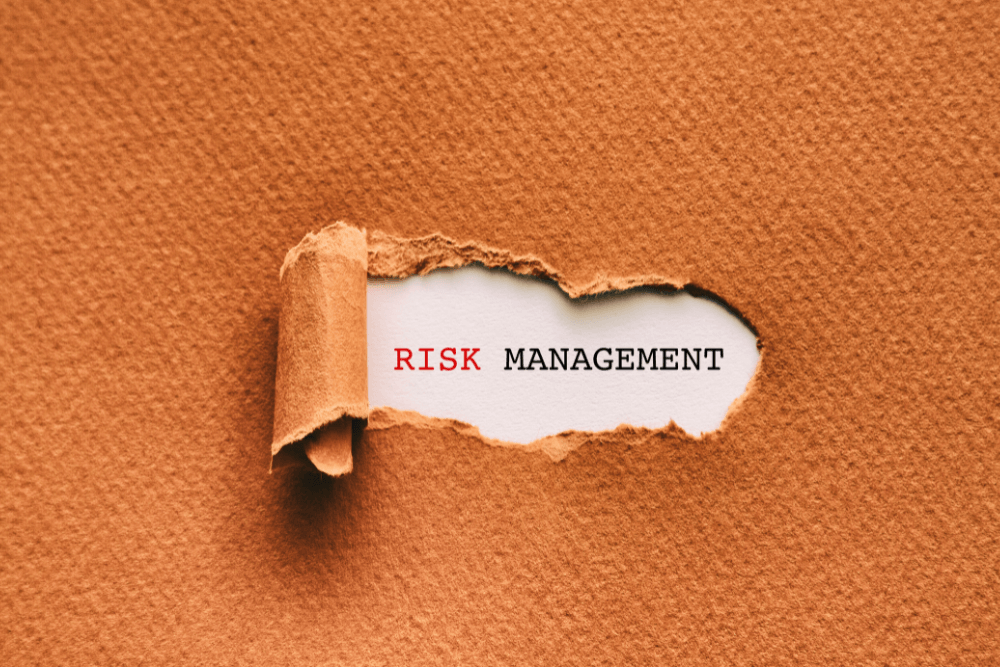
Welcome to the first installment of the four-part Cannabis Risk Management blog series from Valerie Taylor with NCIA Blooming Member The Liberty Company Insurance Brokers, where they’ll journey through the vibrant landscape of the cannabis industry. As a seasoned insurance expert specializing in cannabis, their goal is to illuminate the path to securing your cannabis business, starting with the fundamental pillar – cultivation.
Cannabis cultivation is where it all begins; it’s the heart of the industry. But this thriving world of green has its unique challenges and risks, and that’s where the right insurance coverage becomes your guardian angel. In this blog, we’ll explore the intriguing world of cannabis cultivation, understanding the high-stakes risks, and discovering how to protect your cannabis crop.
The Complex Landscape of Cannabis Cultivation
Cultivating cannabis is both an art and a science. It’s the heart of the cannabis industry, where the magic begins. However, with great potential comes great risk, and understanding these risks is the first step in protecting your investment.
-
Work Comp Claims: Protecting Your Green Thumbs
In the demanding world of cannabis cultivation, dedicated teamwork is vital. However, hard work also brings potential risks in the form of work-related injuries. Employees engaged in activities such as trimming, harvesting, and general maintenance face various injury risks, including repetitive strain and slips and falls. These risks can sprout into work comp claims. To safeguard both your employees and your business, it’s crucial to establish a comprehensive workers’ compensation policy, complete with standardized safety protocols. Additionally, given the electrical complexities inherent to cultivation, it’s critical to engage licensed professionals to mitigate potential electrical hazards.
-
Fire and Equipment Breakdown: A Blaze of Concern
Within cultivation facilities, a multitude of electrical equipment, grow lights, and climate control systems are indispensable for achieving optimal growth conditions. However, they concurrently elevate the potential for fires. The rapid and devastating nature of a fire can swiftly engulf your entire operation, leading to substantial financial losses that many operators may struggle to recover from if they lack adequate insurance coverage. Beyond safeguarding against fires with appropriate insurance, it’s imperative to consider equipment breakdown coverage. This serves as a critical safety net, assuring uninterrupted cultivation by protecting against unforeseen equipment failures.
Sowing the Seeds of Risk Mitigation
Understanding the risks is only the first step; the next is actively mitigating them. By adopting proactive measures, you can fortify your cultivation operation against potential threats.
-
Invest in Safety Measures: Cultivating Safety
To ensure a thriving and secure work environment, make safety your foremost concern. Start by establishing rigorous protocols and offering comprehensive training to your employees. This proactive approach not only significantly reduces the likelihood of work comp claims but also fosters a safety-conscious culture within your workforce, enhancing overall productivity and morale.
-
Fire Safety Systems: Quelling the Blaze
Install top-tier fire safety systems that include smoke detectors, sprinklers, and fire-resistant materials. Regular inspections and maintenance are paramount to ensure these systems are always ready to spring into action.
-
Regular Equipment Maintenance: The Lifeblood of Your Operation
Maintaining your equipment on a regular schedule is essential for the smooth operation of your cultivation facility. By conducting routine equipment inspections and adhering to a stringent maintenance plan, you can ensure that your machinery and systems operate at peak efficiency. This proactive approach not only optimizes performance, but also significantly reduces the risk of costly equipment breakdowns that can disrupt your cultivation rhythm. Regular equipment maintenance is the heartbeat of a reliable and productive operation.
-
Theft Prevention: Safeguarding Your Valuable Investments
It’s no surprise that theft is a prevalent issue in the cannabis industry, primarily due to the substantial capital invested in building and equipping cultivation spaces. The attractiveness of these facilities as targets for theft is evident, with many clients reporting incidents of theft, including the theft of lighting systems and plants. To protect your investments and ensure the uninterrupted operation of your facility, it’s crucial to incorporate theft prevention measures. Implementing security protocols, surveillance systems, and access controls can deter theft and unauthorized access, offering you peace of mind and safeguarding your assets.
Embrace Specialized Cannabis Insurance
Cannabis cultivation isn’t a one-size-fits-all endeavor, and neither is the insurance that protects it. Standard insurance policies often fall short when it comes to understanding the intricacies of this unique industry.
Working with an insurance advisor who specializes in cannabis is pivotal. They have the knowledge to customize policies tailored to your cultivation risks, providing coverage from germination to harvest.
In closing, always remember that knowledge is your best ally in the ever-evolving landscape of the cannabis industry. As we continue this series, we’ll explore the unique risks faced by the retail, distribution, and manufacturing sectors, weaving together a comprehensive understanding of cannabis risk management.
Stay tuned for our next installment, where we’ll venture into the dynamic world of cannabis retail, revealing the distinct challenges and opportunities it brings. Whether you’re a cultivator, retailer, or part of the larger cannabis ecosystem, our mission is to empower you with the insights and insurance solutions you need to thrive in this flourishing industry.
For more information, please reach out to Valerie Taylor, Vice President (National Cannabis Practice Leader), Liberty Company Insurance Brokers.
How Compliant Tech Bolsters Cannabis License Application

Are you contemplating entering the burgeoning cannabis retail market? Whether you plan to open a dispensary in states that recently legalized recreational cannabis, like Maryland and New York, or any legacy states that are still awarding new licenses, the first and most crucial step towards success is ensuring that your cannabis retail license application meets all legal requirements. In this blog post, we’ll explore how compliant cannabis technology can be your guiding light and help you strengthen your license application, helping you navigate the intricate landscape of cannabis laws and regulations.
1. Grasping the Universal Elements in Licensing Requirements
The cannabis industry is a patchwork of regulations, with licensing requirements varying significantly from state to state. Yet, there are shared elements, such as legally binding sales limits, mandatory reporting to government agencies, and indispensable seed-to-sale cannabis product tracking. These commonalities are crucial, and you lay a strong foundation for your journey by understanding and adhering to them. Partnering with a reputed cannabis technology provider and using advanced cannabis software that automates all these requirements at your dispensary will demonstrate your commitment to compliance.
2. Mastering Cannabis Inventory Management
Effective cannabis inventory management is not just the key to your business’s success, it is also the linchpin to obtaining your cannabis retail license. Demonstrating proficiency in this area, including how you will accurately track and report inventory to your jurisdiction, is vital for compliance and regulatory adherence. With the help of the right cannabis inventory management system integrated into your cannabis POS, you can easily corroborate cannabis inventory requirements in your license application.
3. Ready-to-implement Tech Solutions for Key Challenges
If your chosen cannabis software provider provides multiple solutions, you can tackle the following essential aspects of your license application:
- Cannabis POS Requirements: The right cannabis POS solution significantly reduces human errors and ensures precise product tracking. Incorporating it into your business shows your dedication to accurate compliance.
- Automation for Compliance: Utilizing automated technology to oversee compliance matters, like reporting, purchase limits, and operational hours, underscores your commitment to regulatory conformity.
- Local Tracking System Interface: Crafting a strategy for seamless interaction with the local state/provincial tracking system is imperative. This demonstrates your readiness to operate within the regulatory framework.
- Peak Days Support: How the cannabis retail software you choose will support the busiest cannabis retail days of the year is an essential consideration. Being prepared for high-demand periods is a mark of a well-prepared dispensary business.
- Customer Privacy & Data Protection: Developing a plan for safeguarding customer privacy and proprietary information at your dispensary establishment is critical for responsible and secure operation. With the right software, your customer data will always be secure, and your dispensary will remain compliant.
- Multi-Location Inventory: For those with aspirations of business expansion, overseeing inventory across multiple locations is a strategy that can demonstrate your readiness for growth. This is where advanced cannabis software becomes even more crucial.
4. Tailored to Your State’s Regulatory Concerns
Cannabis technology can be customized to address the specific regulatory concerns of your state. Having technology that is adaptable to the nuances of your region is a key asset. This technology is your ultimate companion in navigating the complexities of regulations, helping you successfully secure your legal dispensary license and become a part of this rapidly growing industry. To ensure that your license application meets all dispensary tech and compliance requirements, download Cova’s Free Handbook, which is a great resource to help you submit a successful cannabis retail license application in your state.
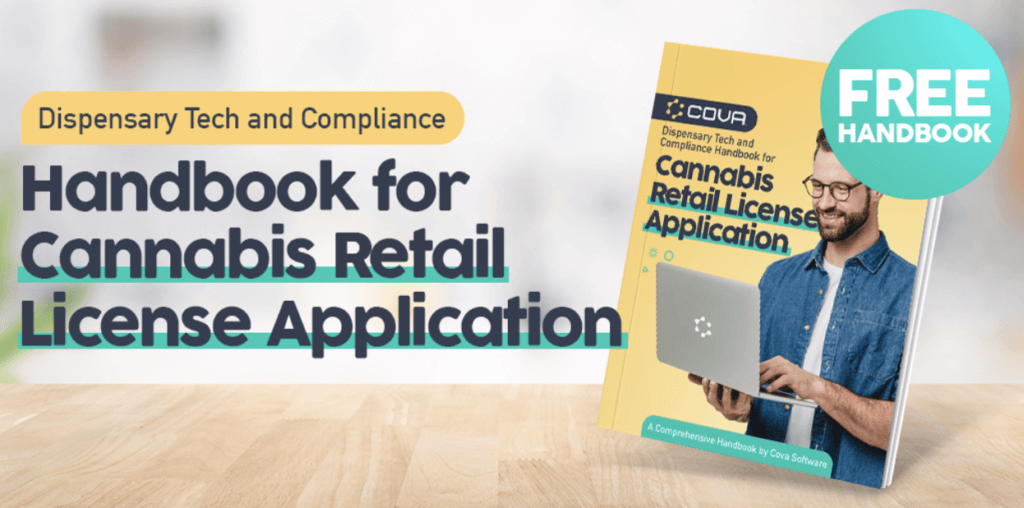
Unveiling Cultivation Secrets for a Record-Breaking Cannabis Yield
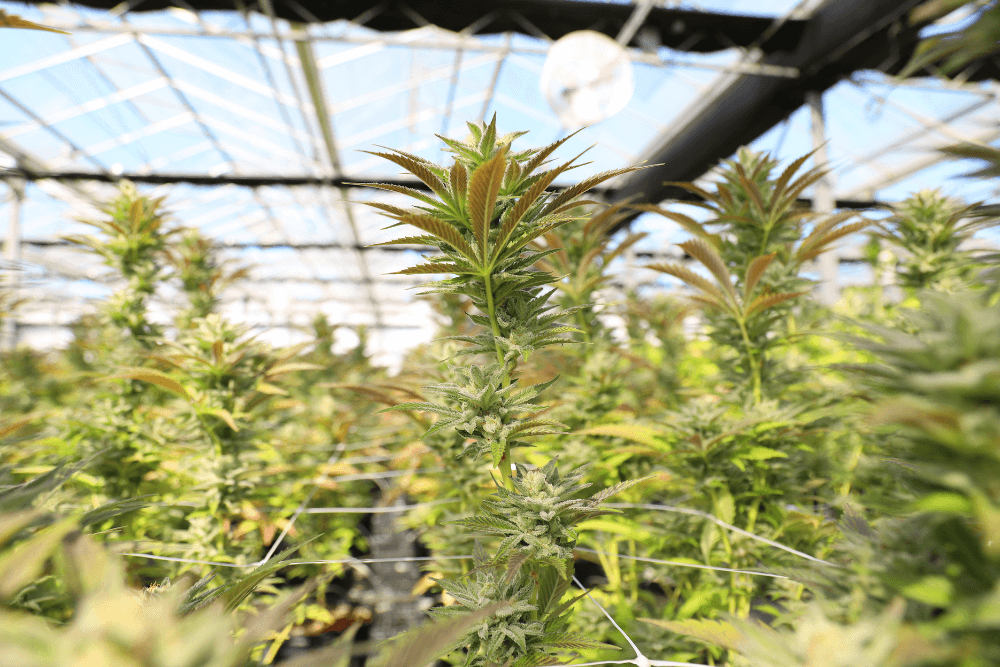
If numbers could talk, they’d tell an incredible story of the rise of cannabis. Now crowned the sixth most valuable crop in the United States, its growth trajectory is nothing short of remarkable.
To paint a clearer picture, in fresh insights from the second annual harvest report by Leafly, we learn that 2022 saw 2,834 metric tons of adult-use cannabis being grown across 15 legal cannabis states. What’s even more astounding is the growth – a 24% increase from the previous year, adding 554 more metric tons to the tally.
Are you reading this because you want to grow more cannabis, too? You’re in the right spot. Here, we’ll disclose the secrets to help boost your cultivation. Let’s begin!
Picking the Right Seeds
Your yield’s potential is, in many ways, determined by the seeds of the plant you’re growing. That’s why it’s important to understand different types of cannabis seeds and what they offer.
Firstly, there are feminized seeds, which are bred specifically to eliminate male chromosomes. This increases the chances of growing a female plant, which is crucial because only female cannabis plants produce the coveted buds you need. According to professionals, choosing feminized seeds means less guesswork and more yield potential.
| One popular feminized seed is the Do Si Dos strain, renowned for its potency and vibrant trichome-rich flowers. It offers a blend of physical tranquility and sensory elevation, making it a favorite among medicinal and recreational users. |
Then, we have auto-flowering seeds. These seeds automatically shift from the vegetative phase to the flowering phase based on age rather than light cycles. They’re great for beginners or those looking for a quicker harvest, as they mature faster than regular seeds.
Finally, there are the regular seeds. These seeds can be both male and female, so growers need to be careful during the vegetative stage to identify and separate male plants, ensuring they don’t pollinate the females.
Pro Tip: It’s essential to source your seeds from reputable sellers. Established seed banks or suppliers often provide detailed information about genetics, expected yield, and growth patterns, ensuring you make an informed choice.
Choosing the Best Soil Mixtures
Cannabis, by nature, prefers soil that is well-aerated and has good drainage capabilities. This ensures that the roots can breathe and access water without the risk of rotting.
For this purpose, you can create a soil mix combining coco coir, perlite, and organic compost. Coco coir will promote root health; perlite ensures proper aeration and organic compost offers essential nutrients for healthy growth.
It’s noteworthy that every strain might have its preferences. Therefore, it’s worth spending time researching and possibly even experimenting with small batches. It will ensure only a limited number of plants are affected (if something goes wrong) and provide clearer insights into what works best for specific strains or under certain conditions.
Ultimately, the right soil mixture will create the difference between a mediocre and a record-breaking yield.
The “Screen of Green” (SCROG) Method
The “Screen of Green” method is not just another cultivation fad; it’s a tried-and-tested method to enhance plant growth and optimize yields. It involves setting a horizontal mesh or net above your plants.
As the plants grow, their branches are gently woven into the screen, allowing for better light exposure and distribution. This promotes even and robust growth as even the lower branches receive adequate light.
But that’s not all! The method also allows plants to utilize space more efficiently. By training the plants to grow horizontally rather than vertically, growers can maximize their canopy space, resulting in more buds and, ultimately, a heftier harvest.
So, if you have limited growing space or are aiming for a stealthy indoor grow, SCROG offers a practical solution. Give it a try and see the results yourself!
Understanding the N-P-K Ratio
The N-P-K ratio is a simple yet crucial gardening component, especially for cannabis cultivation. “N-P-K” stands for Nitrogen (N), Phosphorus (P), and Potassium (K) – the three vital nutrients that plants need to thrive. Let’s dig into the details:
- Nitrogen (N) is fundamental for vegetative growth. It’s responsible for the lush green leaves you see on plants. For cannabis, especially during its vegetative phase, a higher nitrogen level ensures hearty growth.
- Phosphorus (P) plays a pivotal role in root development and flowering. It’s essential when cannabis plants transition to their blooming phase, as it encourages the growth of dense and resin-rich buds.
- Potassium (K) is a kind of all-rounder. It aids in overall plant health, ensures better protection from diseases, and boosts cell structure.
By tailoring this ratio to the plant’s growth stage, you can ensure your plants get precisely what they need and when they need it.
Recognizing Signs of Plant Disease
You’ve acquired premium seeds, perfected your soil mixture, and nailed the ideal N-P-K ratio. But, if you fail to protect your plants from disease, it’s all for nothing.
Diseases can stealthily undermine all your hard work, often taking hold before you even spot them. To avoid this situation, early detection is your best defense, saving both your crop and effort.
So, pay close attention to your plants’ leaves; are they discolored, yellow, or spotty? These could be distress signals sent out due to nutrient imbalances or invasive fungal attacks. Wilting leaves can point towards problematic roots, while unusual spots or mold hint at pest infestations or bacterial onslaughts.
Even a sudden, odd odor from your plant shouldn’t be ignored. Stay alert to these signs, as prompt recognition and action could be your harvest’s lifesaver.
The Best Time to Harvest
When it comes to yielding the most potent and abundant cannabis crop, timing is everything. If you harvest too early, you might miss out on maximum potency. On the other hand, if you are too late, you risk THC degradation.
To ensure you’re hitting that sweet spot, keep an eye on the trichomes – those tiny, mushroom-like glands on your buds. When a majority turn milky white with some amber, it’s usually prime time. Apart from this, monitor the pistils: if they’re more than 70% brown or red, your plant is signaling readiness.
Final Words
Growing a top-notch cannabis plant isn’t just about luck. It’s about knowing what to do and when to do it. So, save this handy guide and refer to it when you wish to grow cannabis. Also, make sure to keep learning, as the more knowledge you get, the better quality plants you can harvest.
Member Blog: Where Is Delta-8 THC Legal and Where Is It Banned? CBD Oracle’s Map Has the Answers
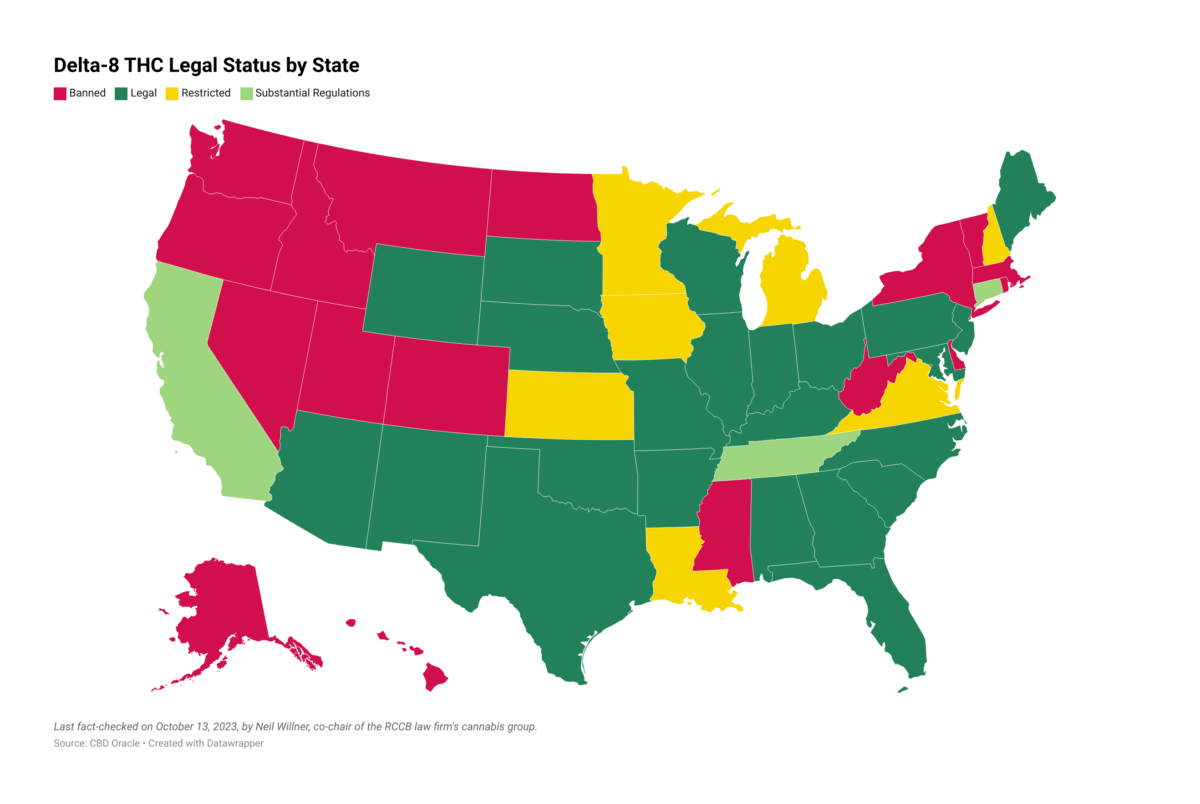
Delta-8 THC is probably the most controversial cannabinoid on the planet right now. With the 2018 Farm Bill being widely considered to have removed the THC isomer from the federal list of controlled substances, hemp and CBD companies quickly found a use for their excess CBD isolate. But if you’re considering selling delta-8 THC, federal law is only a part of the picture, and at state level, you have a patchwork of different laws and regulatory schemes to contend with.
This is why CBD Oracle, working alongside Neil Willner co-chair of the Cannabis Group at Royer Cooper Cohen Braunfeld, has produced a state-by-state map of delta-8 THC’s legality based on extensive reviews of state law. If you want to know what’s going on with delta-8 THC in a specific state, this is one of the best resources around to get the answer you’re looking for.
Delta-8 THC Is Legal in 22 States and 1 District With Limited Regulation
Despite the controversy surrounding delta-8 THC, it remains legal in 22 states and 1 district, with only limited regulation. This covers the following states:
- Alabama*
- Arizona
- Arkansas
- Florida*
- Georgia (?)
- Illinois
- Indiana (?)
- Kentucky*
- Maine
- Maryland* (?)
- Missouri
- Nebraska
- New Jersey
- New Mexico
- North Carolina
- Ohio
- Oklahoma
- Pennsylvania (?)
- South Carolina (?)
- Texas (?)
- Washington D.C.
- Wisconsin
- Wyoming*
Here, a * beside the state’s name means they’ve instituted age restrictions, preventing anybody aged 21 or under from buying delta-8 THC. States marked with (?) are currently involved in legal action about the status of delta-8 THC.
In the majority of these cases, state law basically follows the blueprint laid down by the 2018 Farm Bill with few or no additional rules. In fact, only a handful of states (Alabama, Florida, Kentucky, Maryland and Wyoming) have even passed laws preventing youth from buying delta-8 THC.
Legal actions are ongoing in several states, with the situation being slightly different in each. For instance, in Maryland, the hemp industry won a temporary injunction against the state, preventing the state from enforcing the provisions of House Bill (HB) 556 which relate to hemp until the action is resolved. The bill originally made it so that delta-8 THC products (and most CBD) could only be sold in licensed marijuana dispensaries, but this was deemed by the court to create a monopoly.
Delta-8 THC Is Banned in 17 States and Severely Restricted in 7 More
For every state where delta-8 THC is de facto legal, there is another state which has either banned or severely restricted the cannabinoid. In total, CBD Oracle’s analysis shows that delta-8 THC is banned in 17 states and severely restricted in 7 more. The states with bans are:
- Alaska
- Colorado
- Delaware
- Hawaii
- Idaho
- Massachusetts
- Mississippi
- Montana
- Nevada (technically could be approved for marijuana industry)
- New York (isomerization banned, could theoretically be sold in adult use)
- North Dakota
- Oregon
- Rhode Island
- Utah (possible in medical industry)
- Vermont
- Washington
- West Virginia
And there are severe restrictions – limiting all THCs to be under 0.3% for hemp products, unless otherwise noted – in the following seven states:
- Iowa
- Kansas
- Louisiana (all THCs must be under 8 mg per serving and 1% by dry weight)
- Michigan (all THCs under 0.3% and only marijuana-derived delta-8 allowed)
- Minnesota (all THCs under 0.3% and less than 5 mg per serving)
- New Hampshire
- Virginia (2 mg serving limit or >25:1 CBD:THC ratio)
Exactly how delta-8 THC is banned or restricted varies by state. For instance, while Colorado bans the “isomerization” process used to make delta-8 from CBD, Idaho basically bans anything that contains THC at all, even if it’s just CBD with trace, federally-acceptable levels of delta-9 THC. For the restricted states, most require that all THCs total to under 0.3% by dry weight, which is technically possible for a delta-8 THC product to meet, but essentially none do.
The analysis also revealed that – just like with marijuana – making delta-8 THC illegal doesn’t automatically remove it from a community. In Hawaii and Mississippi, for instance, despite state law banning delta-8 THC, it is still openly sold.
Only Three States Have Substantial Regulations on Delta-8 THC
In California, Connecticut and Tennessee, delta-8 THC is legal but has substantial regulations in place. In California and Connecticut, delta-8 THC is treated as marijuana and is sold as part of the adult use industry. This automatically institutes a wide range of requirements on the cannabinoid, including rules on testing and labeling to ensure safety and transparency for consumers.
Tennessee is the unique case here, where delta-8 THC is regulated as a “hemp-derived cannabinoid” and is legal to sell to adults aged 21 and over. Senate Bill (SB) 378 includes requirements for testing for contaminants, informative labeling and marketing which does not target youths, as well as a 25 mg serving size limit.
The Patchwork of Laws and the Future of Delta-8 THC
The key take-away for sellers of delta-8 THC is that current state regulations are a patchwork, making it very difficult to navigate for even the most responsible of companies. The product you can sell in Arizona without issues is probably not legal in Kansas, and would require batch testing and more to be sold in Tennessee.
This uncertainty may be resolved by the upcoming 2023 Farm Bill, but even this isn’t a sure thing. While the 2018 Farm Bill opened the door to a whole host of products and simply assumed (incorrectly) that the FDA would step up to regulate finished products, the new version might offer the clarity that was lacking. However, it’s just as likely that the bill will redefine “hemp” in a way that excludes delta-8 THC by default.
Pretty much the only thing you can depend on is that you’ll need to keep a close eye on state laws in the coming year. CBD Oracle’s map will be continuously revised to reflect the current legal reality and help responsible hemp companies remain compliant.
______________________________________________________________________________________
Lee Johnson is the senior editor at CBD Oracle, and has been covering science, vaping and cannabis for over a decade. He focuses on research-driven deep dives into topics ranging from medical uses for CBD to industry and user statistics, as well as general guides and explainers for consumers.
CBD Oracle is a cannabis consumer research company working to improve the safety and transparency of cannabis and hemp products, which publishes in-depth scientific, legal and consumer analyses on cannabis and cannabinoids.
Committee Blog: Cannabis Cultivation Facilities vs. Cannabis Retail Facilities – Disparities and Economic Impact

Published by NCIA’s Cannabis Cultivation Committee (CCC)
The cannabis industry has experienced a significant transformation in recent years, with the legalization and decriminalization of cannabis in many regions around the world. This shift has led to the emergence of two distinct yet interconnected sectors within the cannabis market: cultivation facilities and retail facilities. While both play a vital role in the cannabis supply chain, they exhibit notable disparities that have a substantial impact on the economy.
Cultivation Facilities: Nurturing the Green
Cannabis cultivation facilities are the backbone of the industry, responsible for the growth and cultivation of the cannabis plant. These facilities are typically large-scale operations that require advanced horticultural techniques, specialized equipment, and a controlled environment to ensure the optimal growth of cannabis plants. Cultivators must navigate various factors such as lighting, temperature, humidity, and nutrient levels to produce high-quality yields.
One of the most significant disparities between cultivation and retail facilities lies in their resource requirements. Cultivation facilities demand substantial capital investment for equipment, real estate, utilities, and staffing. High-quality lighting systems, advanced climate control mechanisms, and nutrient delivery systems contribute to the significant start-up costs associated with these facilities.
Beyond the financial aspect, cultivation facilities often face regulatory challenges. Licensing requirements, zoning restrictions, and compliance with state and local regulations add another layer of complexity to their operations. However, despite these challenges, cultivation facilities have a direct impact on job creation, local economies, and tax revenues. They provide employment opportunities in rural and urban areas alike, stimulating economic growth and revitalization.
Retail Facilities: The Consumer Experience
On the other end of the cannabis supply chain are retail facilities, where consumers can purchase various cannabis products, including flowers, edibles, concentrates, and topicals. Retail facilities offer a diverse range of products to cater to the preferences and needs of consumers, enhancing the overall cannabis experience. These establishments range from dispensaries to specialized stores and require a different set of considerations compared to cultivation facilities.
Unlike cultivation facilities, retail establishments tend to have lower start-up costs. However, they face their own unique challenges. Navigating a complex web of regulations regarding product labeling, packaging, and sales is crucial for compliance and consumer safety. Retail facilities must also provide a safe and welcoming environment for customers while ensuring age restrictions are strictly enforced.
Retail facilities play a pivotal role in shaping public perception and acceptance of cannabis. As these establishments become more mainstream, they contribute to the normalization of cannabis use and promote responsible consumption practices. This normalization, in turn, has implications for the broader economy.
Economic Impact: Cultivation vs. Retail
The economic impact of cannabis cultivation facilities and retail facilities extends far beyond the cannabis industry itself. Both sectors contribute to job creation, tax revenues, and local economic development. cultivation facilities often require a larger workforce due to the labor-intensive nature of plant cultivation and processing. These jobs span across various skill levels, from horticulturists and technicians to administrators and security personnel.
Retail facilities, while generally employing fewer people per establishment, create job opportunities in customer service, retail management, and education about cannabis products. Moreover, both cultivation and retail facilities contribute to the local economy through real estate demand, leasing agreements, and utilities consumption.
From a taxation perspective, both sectors generate significant revenue for local and state governments. Cultivation facilities are subject to cultivation taxes and other regulatory fees, contributing to state coffers. Retail facilities, in addition to sales taxes, often face excise taxes on cannabis products. These revenues can then be channeled towards public services, education, infrastructure, and social programs.
It’s All Economics
Having more cultivation facilities and fewer retail facilities can have detrimental effects on economic stability. The balance between suppliers and retailers plays a crucial role in maintaining a healthy economy, and an excessive skew towards either end can lead to negative consequences as we are realizing in the current economic state.
A robust economy thrives on competition, which drives innovation, efficiency, and lower prices for consumers. When there are an excessive number of suppliers combined with fewer retailers, this can create challenges in distribution and logistics. Retailers act as intermediaries between suppliers and consumers, helping to streamline the flow of products and information. When there are fewer retailers, distribution networks can become strained, causing delays, inefficiencies, and potential shortages.
Economic stability relies on a balanced employment landscape. An overabundance of suppliers with limited retailers may lead to job losses in the retail sector, affecting consumer spending and the overall labor market. This can create ripple effects across various industries and reduce the purchasing power of consumers, ultimately slowing down economic growth.
Moreover, concentration of power among a few suppliers can lead to monopolistic tendencies, stifling competition and limiting consumer choice. Monopolies can dictate prices, control supply, and hinder market dynamics, negatively impacting economic stability.
Closing Thoughts
The disparities between cannabis cultivation facilities and retail facilities highlight the intricacies of the evolving cannabis landscape. While cultivation facilities require substantial investments in equipment and compliance, retail establishments focus on creating a positive consumer experience and normalizing cannabis use. Together, they form a symbiotic relationship that drives economic growth, job creation, and tax revenues.
As the cannabis industry continues to mature, it is crucial for stakeholders, policymakers, and entrepreneurs to recognize the importance of both cultivation and retail facilities. Striking a balance between these sectors will be vital for achieving a sustainable and prosperous cannabis market that benefits not only those directly involved in the industry but also the broader economy and society at large.
Member Blog: Novel Foods Applications Stalled?

The UK CBD market had an estimated value of £300 million in 2020 and by the end of 2022 estimates had doubled that figure. This goes to show that CBD being deemed a “novel” food in January 2019 has had little impact on market growth and if predictions are right will exceed £1 billion by 2025. With the FSA’s March 2021 deadline long behind us and having made submissions by the deadline, many companies will be feeling comfortable. However, it’s worth remembering that the authorization process is still on-going, so while products that are part of a validated application are allowed to remain on the market they are still not authorized as novel foods. And now with the FSA conducting market research to aid in their risk assessment of consumer CBD products, some concerning data has been published.
The FSA commissioned Fera Science Ltd to carry out a survey to obtain a brief overview of current CBD products on sale in England and Wales in order to help FSA’s risk assessment of CBD products. The products selected covered, oils, sprays and edibles (including drinks). The study collected various data on the products. This included testing for CBD content, cannabinoid profiles, heavy metals, pesticides, residual solvents, Polycyclic Aromatic Hydrocarbons (PAHs) & mycotoxins. A summary of the results are shown below:
- Heavy metals (cadmium, mercury & lead) and arsenic were not detected in the majority of samples, meaning levels were below the limits of quantification of the method. Seven samples contained lead, four samples arsenic and two samples contained cadmium. Mercury was not found in any sample. A definitive statement as to whether products exceed maximum levels cannot be made due to uncertainty as to whether products would be classified as a food (i.e. oil) or a food supplement.
- A low incidence of low levels of mycotoxins, with Fusarium mycotoxins found more frequently than aflatoxins and ochratoxin A, mostly at the methods reporting limit. Three samples were found to contain ochratoxin A at the methods reporting limit.
- A total of seven pesticide residues were found across all of the products (each product was tested for over 400 pesticides). There are no specific Maximum Residue Limits (MRL) for CBD products.
- One oil product was found to have PAHs above the regulated levels, if classed as a product for direct consumption. If classed as a food supplement the PAHs were within regulated levels.
- Three samples contained residual solvents. One product was over the MRL.
- Most products contained CBD close to the declared value. Two oils had substantially different levels than that declared (one higher and one lower). CBD was not detected in one of the drink products. These are potentially non-compliant with compositional and standards requirements.
- Delta 9-THC was detected in 87 % (26) of the samples analysed. Of these 40% (12) were found to have THC+ (the total sum of illicit cannabinoids in the product) above the 1mg threshold.
Although Fera only tested a small number of products, the fact that such a large percentage of products were found to have issues is concerning to say the least. It throws into question how many other products currently on the market that are part of a validated NF application, but aren’t up to spec.
The next question is, are you 100% sure that your current market offerings meet their product specifications? If not then there’s no time like the present to take a closer look at your products and their manufacturing process. It’s also important to remember that if you do need to make changes then these changes need to be updated in your current regulatory filings.
If you would like to discuss this further, please reach out to us at info@arcuscompliance.com.
Member Blog: Unleashing the Green Revolution – Empowering Cash Management in the Cannabis Industry with Automated Bliss

For most cannabis business owners, the abundance of cash poses a never-ending cash management challenge. Owners, staff and financial teams must navigate the complexities of managing and securing large cash volumes with limited access to banking relationships due to the federally illegal status of cannabis. Most dispensaries resort to manual cash handling and counting, however, every time cash is counted manually – typically around six times a day – dispensaries face the risk of miscounts, theft and security threats as well as challenges in tracking volumes, reporting changes and supporting audits.
Handling cash manually is inefficient and unsustainable for new and established dispensaries. Forward-thinking cannabis retailers are turning to automation solutions that transform the collection, counting and reconciliation of cash volumes in a retail setting. Cash automation offers a solid, systemic alternative to the typical cash handling processes.
One medical dispensary in D.C. incorporated cash automation to help with the time-consuming manual counts and to improve productivity. This dispensary, the largest and oldest in Washington, D.C., accounts for 54% of the cannabis sales in the city and accepts multiple payment methods. Cash comprises 40% of sales and is a major pain point for the dispensary’s managers and associates.
Since implementing cash automation solutions last year, the dispensary has improved count accuracy, reduced discrepancies and saved time for its staff, who now can service the 400 – 900 patients who visit each day instead of counting cash for hours on end. Additionally, automation has been a game changer for the dispensary’s accounting team. The finance team can view the exact volume of cash on hand remotely and in-store, informing important business decisions for cash planning, including leveraging available cash on hand for product and services payments and optimizing change order and deposit schedules to reduce armored security and bank costs. Real-time reporting and visibility empower the finance teams to manage cash operations with confidence.
Other benefits include:
- User-friendly dashboard with cash flow visibility integrated with accounting software.
- Notifications on urgent needs, including hardware performance issues, deposit capacity and placing change orders.
- Easy, mobile access to cash balances and transaction history across multiple locations.
- Customizable reporting capabilities for auditing, vendor-specific transactions and overall analysis of every transaction by user/payee, amount and date.
- Security measures to ensure efficient cash counting, balancing to POS and securing cash with high-speed recyclers.
With automation capabilities, cannabis businesses can focus on operational efficiencies, bolster inventory management and systemically ensuring process compliance instead of the time-consuming counts that typically overwhelm employees. As the cannabis industry continues to evolve and expand in 2023 and beyond, embracing cash automation allows dispensaries to thrive while reducing costs and labor and maintaining control over their cash ecosystem.
Member Blog: 5 Things You Need to Do Before You Launch Your Cannabusiness in New York

Cannabis was legalized in New York in 2021, and now the market is starting to fully open up for all types of cannabusinesses across the state. Despite a rocky start to rolling out new licenses, it’s almost time for the general public to dip their toes in and start their own dispensaries.
New York’s legal cannabis market is projected to be worth $4.2 billion by 2027, making it the country’s second-largest recreational cannabis state. It won’t be long before cannabis businesses have hundreds of locations across New York.
Curious about how to open a New York dispensary? Here are five things you need to do to get ready for your blossoming cannabusiness.
Conduct Market Research & Choose a Location
Since many cannabusinesses will be opening up in New York in the next few years, you need to ensure that yours is set up for success from the start. The best way to secure success is by selecting a high-demand area with minimal competition. You can identify lucrative locations by exploring different neighborhoods and conducting market research.
Visit prospective spots in person, instead of just looking at them on a map. You’ll get a much better sense of the feel of the area, the type of people walking through, the surrounding businesses, and more. And if feasible, talking to residents and local business owners will help you to really understand the market.
It is also important to be mindful of the New York zoning laws before securing a location. According to statewide zoning restrictions, a cannabis dispensary can’t be on the same road or within 500 feet of a school and 200 feet from a house of worship. Cities may have additional restrictions to limit the number of cannabis dispensaries in a certain location. Do your research before you get married to a location that won’t work out for logistical reasons.
Apply for a License
You’ll need a license to open a cannabusiness in the state of New York. However, as of October 2023, the path to applying and receiving a cannabis license in the state is a little up in the air.
When applications for the first licenses opened up, New York legislators wanted to ensure that people who were negatively impacted by the state’s previous criminalization of cannabis could apply first. This included people who were convicted of a cannabis offense in New York or were affected by a loved one’s conviction.
Now, starting on October 4, 2023, New York will start accepting license applications from a much broader pool of entrepreneurs. Applications are open to everyone over the age of 21 who does not already have three licenses. This is exciting news for many aspiring cannabusiness owners who were not eligible the first time around.
However, these licenses may not be issued as soon as prospective owners hope. When the state legalized cannabis, its goal was to award half of the retail licenses to people with previous cannabis convictions, racial minorities, women, and veterans disabled during service. Several veterans have filed a lawsuit stating that veterans were unfairly passed over for the early licenses. The judge in the case ordered that the state wait to award any new dispensary licenses until the case continues.
Keep an eye on the New York Office of Cannabis Management’s website for updates on the next round of licensing applications.
Secure Funding for Your Cannabusiness
Opening a dispensary in New York will be expensive. While profits will likely be high once you open, you need to find a way to secure the funding needed to get your cannabusiness operational — which experts say could cost between $500,000 to $2 million.
This figure accounts for a variety of expenses for your cannabusiness, including:
- Licensing and application fees
- Lawyers and consultants
- Real estate
- Dispensary design and construction
- Staffing
- Business equipment
- Surveillance and security system
- Marketing and advertising
- Products and inventory
Many cannabis entrepreneurs take out loans to cover these up-front costs, either from credit unions or cannabis-friendly banks. Some are able to partner with others or enlist investors to start their businesses. However, you should do your due diligence and research before taking on a loan or going into business with an investor. Unfortunately, there has been some predatory lending occurring in the market because of the inability to lend from large banks. Make sure that you do this research before you get too far in the process of creating your cannabusiness.
Understand Cannabis Laws & Regulations in New York
There are hundreds of laws and regulations that apply to cannabusinesses in New York. While this can feel overwhelming, it’s important to follow them carefully, especially when you’re setting up your dispensary.
There are some regulations that apply to your customers that you’ll need to adhere to, including:
- Customers must be over the age of 21
- Customers can only buy 3 ounces of cannabis flower per day
- Customers can only buy 24 grams of cannabis concentrates per day
Others regulations apply to your business location, including:
- Installing a 24-hour commercial-grade security system
- Installing a perimeter alarm
- Conducting video surveillance in every part of the store with cannabis products
- Products cannot be visible from outside of the store
- Maintaining minimum staffing levels (depends on business plan submitted with application)
- Training staff on local ordinances, laws, and cannabis safety
It’s vital to take these rules seriously from the beginning. Neglecting even a single law could result in your dispensary getting shut down. You can consult an extensive overview of the New York cannabis laws and regulations here.
Invest in the Right Team
You need to hire a team of high-quality employees who will help your business succeed from the very first day. Your budtenders can make or break your entire business model, so you need to vet them carefully and train them well.
Your budtenders will be interacting directly with clients. They’ll answer their questions, suggest products, and upsell items. Hire these employees carefully, and make sure they’re happy in their positions by offering great pay and benefits.
To streamline training, create training manuals and SOPs (standard operating procedures) so that every employee is trained in the same way. This will limit mistakes and increase efficiency and customer satisfaction.
Final Thoughts on Launching Your New York Cannabusiness
Cannabis is expected to become a booming industry in New York. If you’ve always dreamed of opening a cannabusiness, now’s your chance to get in as early as possible and make your impact on the market!
Committee Blog: Production of Cannabis Infused Products – A Guide to Optimal Facility Design and Workflow

Published by NCIA’s Facilities Design Committee
The burgeoning cannabis industry continues to grow and diversify. One sector that’s seen significant expansion is cannabis-infused food production. In this industry, meticulous facility design is crucial to ensure product quality, worker safety, and regulatory compliance.
This article discusses key design considerations for creating an efficient, safe, and regulation-compliant cannabis food production facility.
Begin with the End in Mind
This may seem more philosophical than operational but adopting this mindset early in your design process can help you avoid common pitfalls that seem to plague even experienced cannabis professionals. So, what does it mean to “begin with the end in mind?” It simply means that you need to define a lot of aspects of your business before you begin design. A very simple example of this is: What product(s) do you want to produce in this facility?
This might seem like a simple question, but there is tremendous complexity lurking just below the surface. While a commercial kitchen in a facility such as a restaurant might be a very flexible space allowing for the production of multiple products using the same space and equipment, food manufacturing of shelf-stable products requires a bit more specificity. Let’s pick a single product as an example: Gummies. Here are a few questions and decision points that need to be addressed before diving into design specifics:
- Do you have a recipe for your gummies?
- Does your recipe require specific equipment for production? Does that equipment require ventilation (i.e., a hood)?
- Have you set throughput and volume targets for production (i.e., how many gummies do you want to produce per hour/day/month, etc.?)
- How will your product be packaged?
- Will more than one type of product be produced in this same room/area?
- If so, how do you plan to mitigate cross-contamination risks?
- Have you defined a facility workflow that maps a product’s process from component parts (ingredients) to processing to packaging to storage and delivery?
This is a very incomplete list but demonstrates the fact that a simple product decision comes with a multitude of related decisions that must be made to successfully implement the production process. For example, your decision on your facilities throughput goals directly impacts your equipment choices. Are you doing artisanal, hand-crafted gummies in small batches or are you producing gummies at scale for maximum throughput?
Do you plan to start with one product and eventually expand to other products? Knowing this in advance allows you to strategically plan for those potential line-extensions. The design of an area in your facility to produce one kind of product does not necessarily effectively translate to the production of a different product. The equipment, space-planning, and process-planning for the production of gummy products is very different from the production of baked edibles or chocolate edibles for example. Knowing what you ultimately want to do can help you strategically design for the future and avoid potentially costly retrofits. There is no “one-size-fits-all” cannabis kitchen design.
Another important consideration is the development of Standard Operating Procedures (SOPs). SOPs are a key component of developing Good Manufacturing Processes (GMP) which is becoming increasingly critical to manufacturing in the cannabis industry. Understanding and documenting how things should be done will give you key insights into what is needed in your overall facility design.
This mindset of working backwards from your goal can be applied to almost every aspect of your operation. This includes things such as labor schedules, purchasing guides, order scheduling, storage, packaging, delivery and more. Define your goals and outputs and then work backward from there.
Space Planning
The first crucial consideration is space planning. It is imperative to account for all operational aspects of the facility, from storage and production to packing and shipping. Ensuring there is adequate space for these activities contributes to the workflow efficiency and helps maintain a safe work environment.
Storage areas should be designed to accommodate raw materials, finished products, and waste materials separately. Temperature-controlled areas may be necessary for perishable ingredients or to maintain product stability.
Production areas need sufficient space to house specialized equipment for cannabis food production. These can include extraction machines, distillation other laboratory equipment, infusion systems, and commercial kitchen appliances for food preparation. The areas should also facilitate the movement of employees and materials.
Packing and shipping areas need to accommodate packing materials, finished product cases, and space for shipping operations. Depending on your scale, this may include room for pallets, forklifts, or other necessary equipment.
Workflow Design
An optimized workflow is critical for efficiency and safety. The design of the facility should facilitate a streamlined flow of materials from receiving to shipping. This ‘one-way’ flow can help prevent cross-contamination and reduce movement of personnel and materials.
Special consideration should be given to the workflow around extraction and infusion processes. These are complex and sensitive steps that involve precise control over temperature and pressure. The facilities should be designed to allow for these activities to be conducted safely and efficiently.
Equipment Planning
When planning for equipment, several considerations come into play. Firstly, understanding the power requirements for the extraction, infusion, and food production equipment is paramount. Adequate electrical infrastructure needs to be installed to meet these demands.
Drainage is another critical consideration. Extraction processes can produce significant waste that needs to be safely disposed of. Furthermore, commercial kitchen operations require a professional-grade drainage system.
Lastly, space must be set aside for regular equipment maintenance and potential upgrades. The rapid pace of innovation in the cannabis industry means equipment can quickly become outdated and need replacement.
Food Safety Best Practices
As a food production facility, following best practices for food safety is a must. This includes implementing Hazard Analysis and Critical Control Points (HACCP) plans to identify potential hazards and establish procedures to mitigate them.
Facilities must ensure appropriate hygiene measures, including handwashing stations and employee changing areas. Special attention should be given to allergen management, considering the diversity of ingredients that could be used in cannabis-infused foods.
Proper ventilation is a key factor in maintaining air quality and controlling odors, which can be a significant issue in cannabis production facilities. An effective ventilation system will also help control humidity, which can impact both the quality of the product and the longevity of the equipment.
Putting It All Together
The design of a cannabis food production facility is a complex task requiring a clear understanding of the production process, equipment requirements, safety considerations, and regulatory compliance. Through thoughtful planning and design, producers can build a facility that not only meets these demands but is also flexible enough to adapt to the ever-changing landscape of the cannabis industry.
Member Blog: Effective Ways to Build a Buzz Around Your Cannabis Business

The cannabis industry is more than just sprouting; it’s flourishing at an incredible pace.
According to the U.S. Cannabis Report: 2020-2021 Industry Outlook, annual legal sales (covering both medical and adult use) are projected to increase at a CAGR of 21%. By the year 2025, the market is expected to be worth a staggering $50 billion, up from $13.2 billion in 2019.
As a matter of fact, these numbers are not just statistics on a page; they present a golden opportunity for entrepreneurs in the cannabis sector.
But let’s be clear: tapping into this booming market is no walk in the park. The competition now is fierce (more than ever). That’s why, as a cannabis business owner, you need to focus on marketing or, more specifically, buzz-building.
Now the question is: How can you ignite interest and keep the conversation going around your cannabis business? Continue reading this article to get the answer!
Optimize Your Website and SEO
Your website is like your online storefront; it’s often the first place people go to learn about your business. When you have a well-designed and easy-to-navigate website, it can turn curious visitors into loyal customers.
But what’s the use of a great website if no one can find it? That’s where SEO, or Search Engine Optimization, comes in. When your target audience looks for products or services related to yours, SEO will help your website show up in search engine results.
Two Simple SEO Strategies to Implement:
- Keyword Research: Find out what words or phrases people use to search for cannabis products like yours. Once you’ve identified these keywords, include them naturally in your website’s content, titles, and meta descriptions.
- Local SEO: If you have a physical store or primarily serve a specific area, make sure to include location-based keywords. For example, if you’re based in Denver, use phrases like “Denver cannabis store” or “best cannabis in Denver” in your website content and meta tags.
These strategies will give you a kick-start by improving your website’s visibility and attracting more customers.
Play with Coupon and Promo Codes
Everyone loves a good deal, and your target customers are no different. Offering discounts, coupons, and promo codes is a quick and simple way to get them talking about your business. It ideally has two benefits:
- It makes your products more appealing.
- It encourages first-time buyers to give your brand a shot.
To make this strategy even more effective, you can consider submitting your coupon to websites like 420CouponCodes.com and tap into their existing audience. It gives a direct channel to potential customers (who are already interested in products like yours) to connect with your brand. It’s like fishing where the fish are already biting!
Moreover, once your customers start using these codes, they will likely share them with friends and family, naturally building buzz around your business.
Leverage Customer Reviews
There’s no denying that in the cannabis industry, word-of-mouth can make or break any business. So, you must encourage your customers to leave reviews about your products and their experience with your brand. If there’s an issue you’re unaware of, a customer review can bring it to your attention so you can fix it.
But that’s not all. Most people check online reviews before making a buying decision; they want to know what others think before they take the plunge. Platforms like 420 Friendly™ are emerging as valuable resources for this purpose. It allows users to leave comments, rankings, ratings, and recommendations about various businesses in the cannabis sector.
By encouraging such reviews, you show your customers you care about their feedback. This, in turn, builds trust among them and boosts the brand’s goodwill.
Develop a Strong Brand Identity
Brand identity is like the face and personality of your business; it’s what customers see and feel when they interact with you. But do you know that it goes beyond just having a catchy name and a cool logo? It should represent the value you hold, the quality of your products, and the kind of experience you want your customers to have. Let’s take an example to understand this better.
Suppose your cannabis business specializes in organic, locally sourced products. In that case, your branding could include earthy colors and natural images to convey a sense of wellness and sustainability. A catchy slogan like “Grown Local, Felt Global” could further emphasize your business’s focus on quality and community.
This way, when people come across your product, they instantly know what you stand for and why they should choose you over competitors.
Tip: Conduct a brand audit before you even start the branding process. It will help you answer key questions like:
- What are the strengths and weaknesses of your current branding?
- What do your potential customers value most in a cannabis brand?
- What do your competitors do well, and where do they fall short?
Don’t Neglect Geotargetting
Finally, if you’re keen on making a splash in the cannabis industry, you can’t afford to overlook geotargeting. This simply means focusing your marketing efforts on a specific local area or community. But why does it matter?
Well, laws and regulations for cannabis differ from place to place. What works in one location might not be applicable in another. Plus, local customers love supporting businesses in their community.
There’s another reason you should focus on geotargeting. According to a study conducted by Localiq, approximately 40% of baby boomers go to a dispensary because it’s near their home or work. So, if you focus on geotargeting, you attract the locals and increase your sales.
Moreover, it’ll allow you to tailor your promotions, advertisements, and even your products to better suit the needs and tastes of the local crowd. And that’s definitely the wise step to becoming the go-to spot for the community.
Summing It All Up
These are a few ways in which you can build a buzz for your cannabis business. But it’s worth stating that it’s an ongoing process. So, you must create the right mix of branding, social media engagement, influencer collaborations, community outreach, and a robust online presence. This way, you can stand out from the crowd and make your brand a household name.
Member Blog: Management Science Associates, Inc. Leads Research Initiatives Alongside Vireo Health

Contributing Authors: Geoff Atkinson, Senior Data Analyst, Management Science Associates, Inc. | Madeline Grant, Business Development Manager, Management Science Associates, Inc. | Paloma Lehfeldt, Director of Medical Education, Vireo Health
One of the promising uses for medical cannabis is treating chronic pain, potentially reducing or replacing prescription opioids and thus reducing the number of overdoses and deaths. Due to the legal status of cannabis and its schedule 1 status on the Controlled Substance Act, there has not been a significant amount of clinical research into its efficacy as a replacement or adjunct therapy for opioids, or its optimal dosing. Unfortunately, due to the lack of research and data there remains uncertainty for patients’ access to pain management and relief through cannabis. The limited research and data availability create uncertainties around patients’ access to cannabis for pain relief. Considering this, Management Science Associates, Inc. (MSA) has taken the initiative to collaborate with cannabis operators such as Vireo Health, aiming to investigate the impact of cannabis consumption on patient health outcomes by utilizing real-world healthcare data. This empirical data is crucial for enhancing our understanding of the complexities surrounding cannabis usage.
MSA and Vireo Health Study
MSA partnered with Vireo Health of Minnesota to complete a first of its kind study for Minnesotan medical patients in the state’s programs. We focused on several hundred customers from eight Vireo dispensaries across Minnesota. Using MSA’s patented de-identification software the data reflected that customers of eight dispensaries in Minnesota reduced their legal opioid usage by an average of 30%. A comprehensive analysis illustrated that these customers, on average, consumed 115 mg of morphine equivalent (MME) per month to their initial cannabis purchase. During the period of cannabis consumption, this figure decreased to 80 MME/month, representing a significant 30% reduction. Notably, opioid prescriptions reverted to higher levels after customers completed their final cannabis purchase. While individual circumstances may necessitate specific medication usage, aggregating data over larger cohort allows for capturing overarching trends.
Once we established, in this particular data set, cannabis may aid in reducing opioid use, we examined additional contributing factors in more detail to determine which patients had the most success. Using MSA’s patented de-identification technology, an individual’s cannabis purchases was matched with their prescription records while maintaining the confidentiality of personal health information. Understanding the connection between cannabis purchasing trends and medical outcomes could be very valuable in making informed decisions about dosing and connecting customers to the products that most effectively meet their particular needs. With the limited clinical research in particular randomized control trials in the United States, there is not nearly as much of this kind of information available for cannabis as there is for more traditional pharmaceuticals. Studies like this are crucial to gather credible data for medical patients to purchase and consume the correct products and dosage.
Continued Results of the MSA and Vireo Health Study
One initial observation is that the impact of cannabis on opioid prescriptions is different for different age groups. Individuals under the age of 45 experienced a 47% decrease in opioid prescriptions, while the 45–64 age group saw an average drop of 35%. Those over the age of 65, who tended to have the highest amount of opioid prescriptions across all three time periods, saw no significant decrease during the time they were purchasing cannabis. There were small differences between men and women. Women used more prescription opioids overall but saw a slightly greater percentage decrease when they began purchasing cannabis.

These differences may be related to different demographic groups preferring different forms of cannabis. The table below shows several forms where there were significant differences in percentage of total cannabis spending by age or by gender. For example, younger customers spent more on vape cartridges, and males tended to spend more on flower.
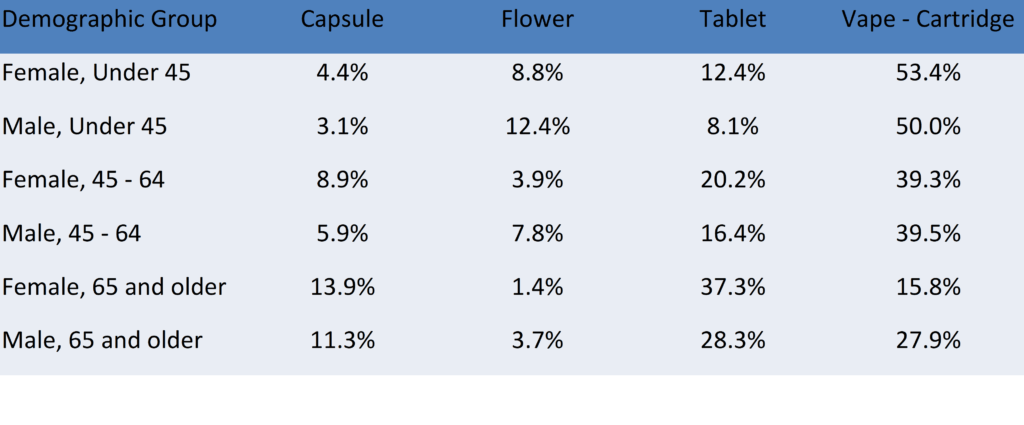
Interestingly, there appears to be no substantial correlation between the total amount of THC purchased and the successful decrease in opioid prescriptions. There was high variation between individuals, but the group of patients who succeeded in reducing their opioid prescriptions purchased an average of 418 mg of THC per month. Those who showed no decrease in opioid prescriptions purchased an average of 563 mg of THC per month. However, those who successfully reduced their opioids did show a preference for products with a high ratio of THC:CBD, spending over 70% of their cannabis budget on products with a ratio of 19:1 or higher.
We also examined the connection between different forms of cannabis and patients’ decrease in opioid prescriptions. One interesting way to divide patients is whether they focused on buying one form of cannabis or sampled many different products to find something that would benefit them. Patients who spent over 60% of their total cannabis budget on one form saw an average decrease of 16% in their opioid prescriptions. Patients who were less focused on one form saw an average decrease of 44%. A conflating factor in this analysis is that customers who purchased many different forms of cannabis also tend to have longer periods of cannabis usage. Customers who tried one or two forms of cannabis averaged 136 days between their first and last purchase. Customers who tried three or four forms of cannabis averaged 342 days. Customers who tried five or more forms of cannabis averaged 833 days.
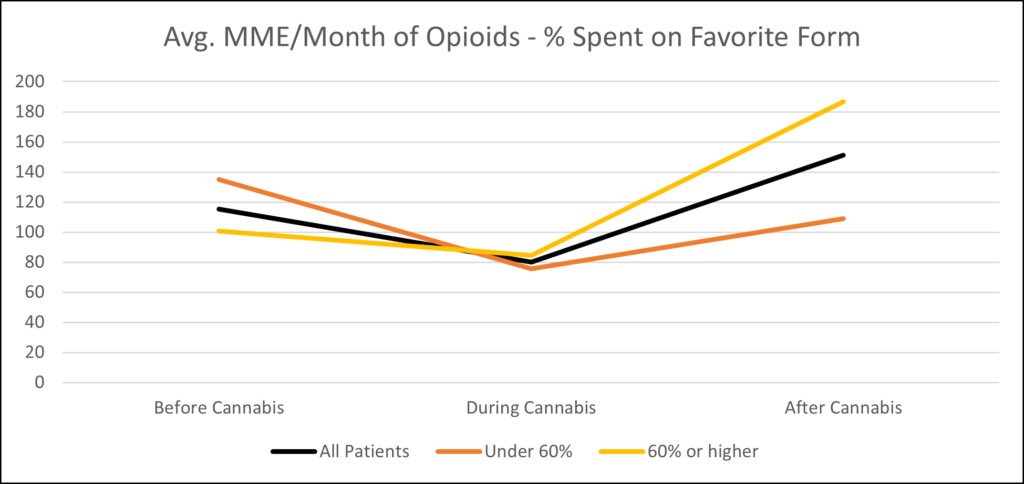
Another way to study the efficacy of particular forms of cannabis is to group patients by their preferred form. For example, customers who spent the majority of their cannabis budget on capsules saw a 63% reduction in opioids while those who preferred tablets saw a 34% decrease. Customers who purchased mostly vape products (the most popular form in these particular dispensaries) saw a 28% decrease, but less rebound towards earlier levels after they stopped purchasing cannabis. Some of these analyses are less statistically significant because of the relatively small number of customers in each group.
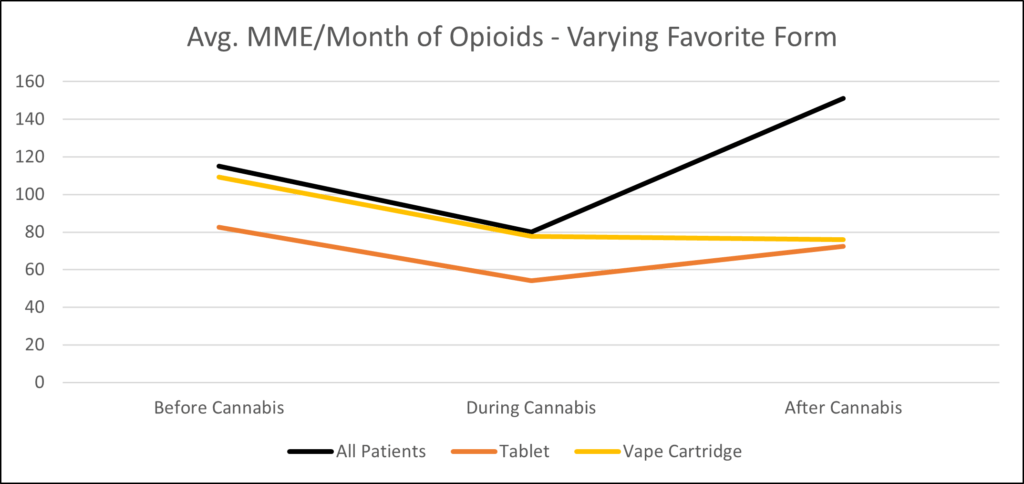
Next Steps
While these preliminary findings are intriguing, they underscore the necessity for further research. MSA will continue to look at cannabis customers across multiple states, where different types of products may be available, which might either reinforce our findings, or illuminate some interesting differences between customers in different markets. Looking at more total customers would increase the significance of the findings relating to customers’ preferred forms of cannabis, which would be very helpful in pointing future customers towards the products most likely to help them. MSA will continue to work with cannabis companies, healthcare professionals, advocates, and policymakers across the United States to conduct studies and continue to share reliable data with the cannabis industry.
If you are interested in learning more or getting involved with MSA by being a prominent leader in medical cannabis research, we’d love to hear from you. You can reach out to Madeline Grant at mgrant@msa.com to schedule an introductory call.
Member Blog: The Importance of PCI Compliance for Cannabis Payments at a Dispensary

The cannabis industry has witnessed exponential growth recently, with legalizations sweeping across various states. The demand for cannabis products is soaring, prompting dispensaries and retailers to explore the convenience of digital payment solutions to meet customer preferences. However, in this rapidly evolving landscape, compliance with industry regulations is paramount, especially when processing cannabis payments securely. This blog post delves into the significance of PCI compliance for dispensary payments, highlighting the potential penalties for non-compliance and the need for a fully compliant cannabis payment processing solution.

The Booming Cannabis Market and the Rise of Digital Payments
The growing cannabis market has paved the way for cannabis retailers and dispensaries to embrace digital payment options to cater to their customers’ convenience and preferences. As more consumers seek cashless and contactless payment methods, integrating digital payments into dispensary operations has become essential. However, the dynamic nature of the cannabis industry requires strict adherence to security and compliance standards.
Understanding Cannabis PCI Compliance and its Significance
PCI DSS (Payment Card Industry Data Security Standard) is a set of security standards designed to protect cardholder data during payment processing. Compliance with PCI DSS is mandatory for all organizations that accept, process, store, or transmit credit card information. In the cannabis industry, where the risk of fraud and cyber threats is high and consumers are more reluctant to share personal information, adhering to PCI compliance is crucial for safeguarding sensitive customer data and maintaining trust with your clientele.
Risks of Inadequate Cannabis Payment Processing Solutions
Using inadequate or illegal payment processing solutions like cashless ATMs, that are not fully compliant with PCI standards poses significant risks for cannabis retailers. Such solutions may leave cardholder data vulnerable to hacking attempts and data breaches, leading to financial losses and damage to the dispensary’s reputation. As the cannabis industry attracts attention from cybercriminals, investing in a robust and PCI-compliant payment processing solution becomes a proactive step towards safeguarding your dispensary’s future.
Penalties for Non-Compliance with PCI for Dispensary Payments
Failing to comply with PCI DSS can have severe consequences for cannabis retailers and dispensaries. All major digital payment processing companies enforce compliance and may impose substantial fines on businesses that do not meet the required regulations. These fines can range from thousands to hundreds of thousands of dollars per month, depending on the severity of the breach. Additionally, non-compliant businesses may face reputational damage, customer loss, and legal actions, potentially threatening the very existence of your dispensary.
The Role of PCI Compliance in Building Customer Trust
Customer trust is paramount in any business and the cannabis industry is no exception. When customers choose to shop at a dispensary, they expect their personal and financial information to be handled securely. Compliance with PCI DSS standards protects cardholder data and instills confidence in customers that their transactions are safe and their privacy is respected. Building this trust fosters loyalty and encourages repeat business, ultimately benefiting your dispensary’s bottom line.
Choosing a Compliant Cannabis Payment Processing Solution
To mitigate the risks associated with non-compliance and ensure that digital payments are processed securely, cannabis retailers must prioritize using a fully compliant payment processing solution. A reputable payment provider specializing in the cannabis industry can offer end-to-end encryption, tokenization, and secure payment gateways to protect sensitive customer data. By partnering with such a provider, dispensaries can process transactions safely and enhance customer trust without worrying about regulatory pitfalls.
A compliant cannabis payment processing solution is a non-negotiable requirement for dispensaries to stay ahead in this competitive landscape. Compliance is crucial, but various other considerations must be taken into account when choosing a cannabis payment processing solution. Cova’s free dispensary payments guide is a great resource to learn more about seamlessly transitioning to cashless payments. By embracing PCI DSS standards and prioritizing secure payment processing, cannabis dispensaries can foster customer trust, comply with industry regulations, and propel their growth in this exciting and evolving market.
Member Blog: Transforming Your Cannabis Business with Modern Experiences
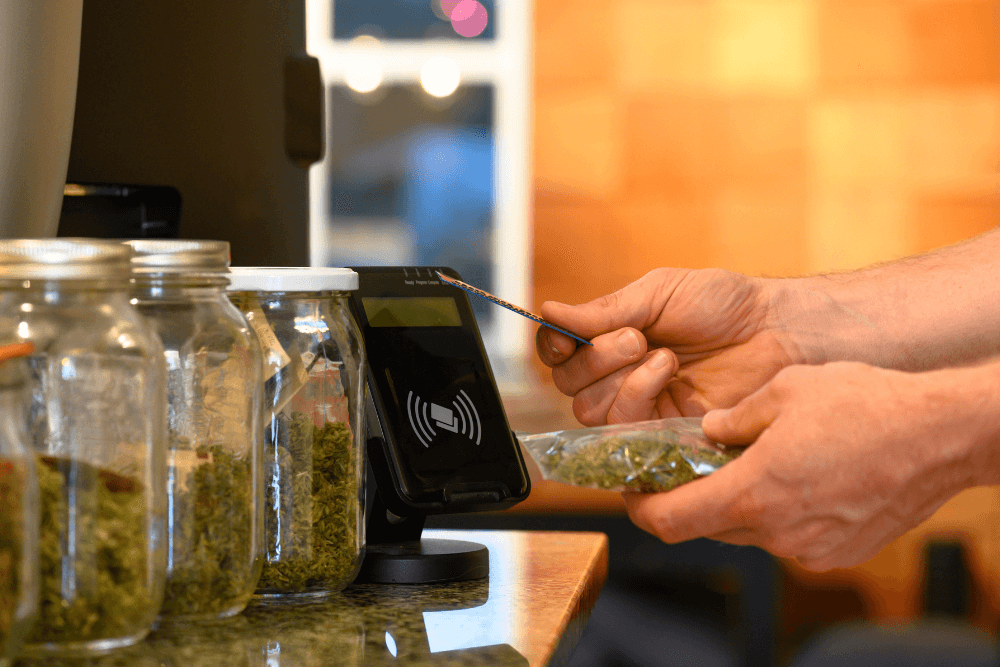
The cannabis market is growing globally at a considerably good pace. According to studies, did you know that increasing legalization, favorable cultivation norms, and the use of technology are some of the factors promoting the development of the cannabis industry?
Due to this, many researchers are projecting the growth of this market from $43.2 in 2022 to $72 billion in annual sales by 2030. While the industry as a whole is growing, however, some businesses are looking for ways to bring something new to customers.
But the question is, when change is the only constant in this market, how can you do it right? Well, don’t worry because we’re here to help.
This article mentions a few tips and suggestions on transforming your business with modern experiences and growing your profits. Let’s dig in!
Install Kiosks for a Better In-Store Experience
One of the best modern ways to elevate your cannabis store is to introduce user-friendly kiosks. These will help your customers find everything easily in the store.
Moreover, you can also increase the product range with these kiosks. For example, if you sell dry herbs, you can also place a station for pre-roll cones to transform into a one-stop store. You can buy pre-roll cones in bulk and make an addition to your business.
It will increase your customers’ convenience and boost your sales for better profits. So, invest in kiosks to transform the in-store experience and align with today’s shopping trends.
Embrace Technology
Another key player in providing a modernized experience to your customer is leveraging technology for your business. You should invest in user-friendly apps and convenient online delivery services to elevate customer experiences.
It is a great way to tap into the target group that seeks convenience and accessibility. Busy schedules often keep people busy, and they may not get the time to visit stores. Thus, providing an app to place orders makes it easier for them.
Likewise, you can consider further offering 24/7 delivery services to accommodate varying schedules and situations. It will not only increase your customer base but also help you stand out among your competitors.
Workshops and Events
Embrace a fresh approach to your cannabis business transformation by hosting workshops and events. It greatly enhances modern experiences. These gatherings help establish strong customer relationships and bring mutual benefits.
For customers, it’s a chance to learn, explore, and connect with fellow enthusiasts. They gain valuable insights into your products and their uses. Your business, in turn, gains loyalty and trust by offering educational and interactive opportunities.
You can conduct these events online and offline according to the demand. You can also introduce games, outings, and more for the community. Moreover, to enhance it further, you can also offer special discounts to the ones who attend your events. This positive connection leads to repeat visits and word-of-mouth recommendations.
Bottom Line
We hope the above information helps you modernize your cannabis business for success. You can use kiosks for easy shopping, embrace technology for convenience, and host engaging workshops. This builds happy customers and loyalty. These steps cater to changing preferences and show you’re a leader.
Member Blog: Cannabis Strain, Cultivar, or Variety? What Is the Correct Term?
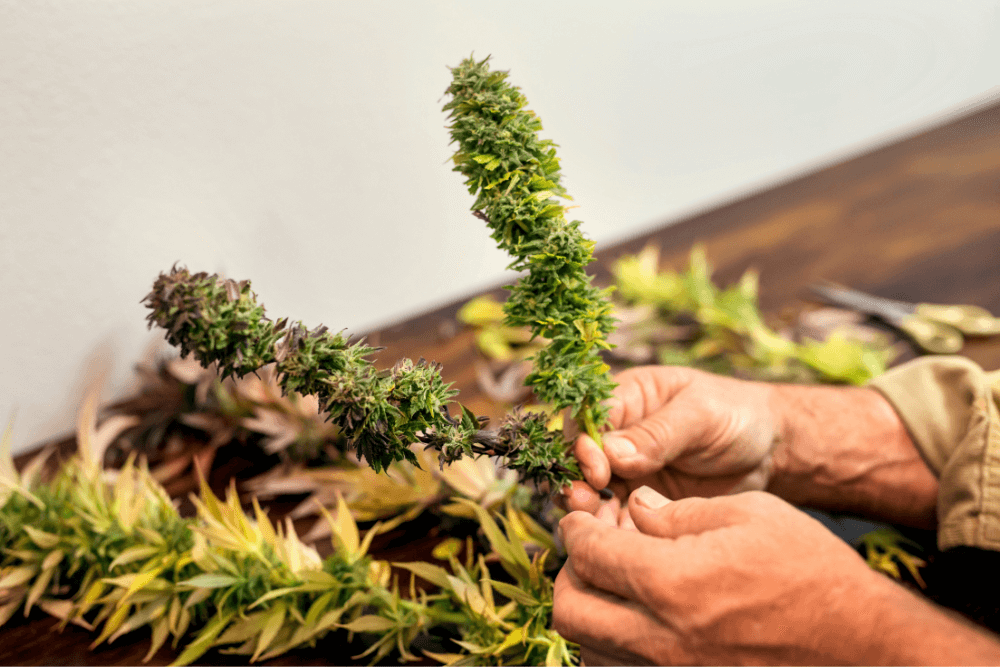
In cannabis cultivation, one often comes across the terms ‘strain,’ ‘cultivar,’ and, more commonly, ‘variety’ to describe the multiple variants of this versatile plant. While these terms are sometimes used interchangeably, it is crucial to acknowledge that each carries a unique significance. Accurate communication is truly important in this dynamic field, and gaining a comprehensive understanding of these differences is essential. In this article, we embark on a journey to unravel the dissimilarities among strain, cultivar, and variety in cannabis cultivation, shedding light on the nuances that shape this captivating community.
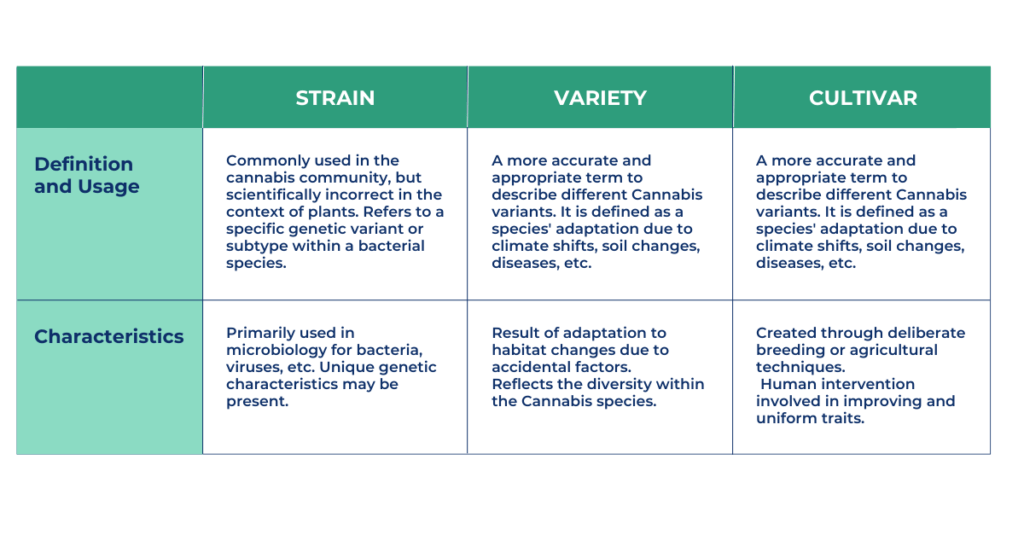 Strain
Strain
Commonly used in the cannabis community, the term “strain” is not entirely accurate when referring to variants of the Cannabis species. In scientific contexts, “strain” is primarily used in microbiology to discuss bacteria, viruses, and fungi (Russo, 2019). For example, in bacteriology, a “strain” refers to a specific genetic variant or subtype within a bacterial species. Each strain may have unique genetic characteristics, such as the presence of specific genes (Dijkshoorn et al, 2000).
However, when it comes to plants like Cannabis and plants in general, the use of the term “strain” is not appropriate, as it is a word reserved for the realm of microbiology. Therefore, we should avoid using it when referring to different variants of Cannabis species.
Variety
The term “variety,” on the other hand, provides a more accurate and appropriate way to describe different cannabis variants. The term “variety” is defined as a species’ adaptation resulting from changes in its habitat due to accidental factors such as climate shifts, soil changes, the presence of diseases, insect attacks, nematodes, and other similar influences (Arévalo et al., 2006). Therefore, when discussing different types of cannabis, “variety” is the most accurate term to use.
Cultivar
To avoid confusion with the botanical term “variety,” the term “cultivar” was coined. It is a combination of “cultivated variety,” shortened to “cultivar” (Arévalo et al, 2006). Unlike varieties, cultivars are not products of natural evolutionary processes. Instead, they are created through deliberate breeding or agricultural techniques to have improved and uniform traits (Tooker et al, 2012). This distinction is crucial, as it highlights the human intervention involved in developing specific plant traits and characteristics.
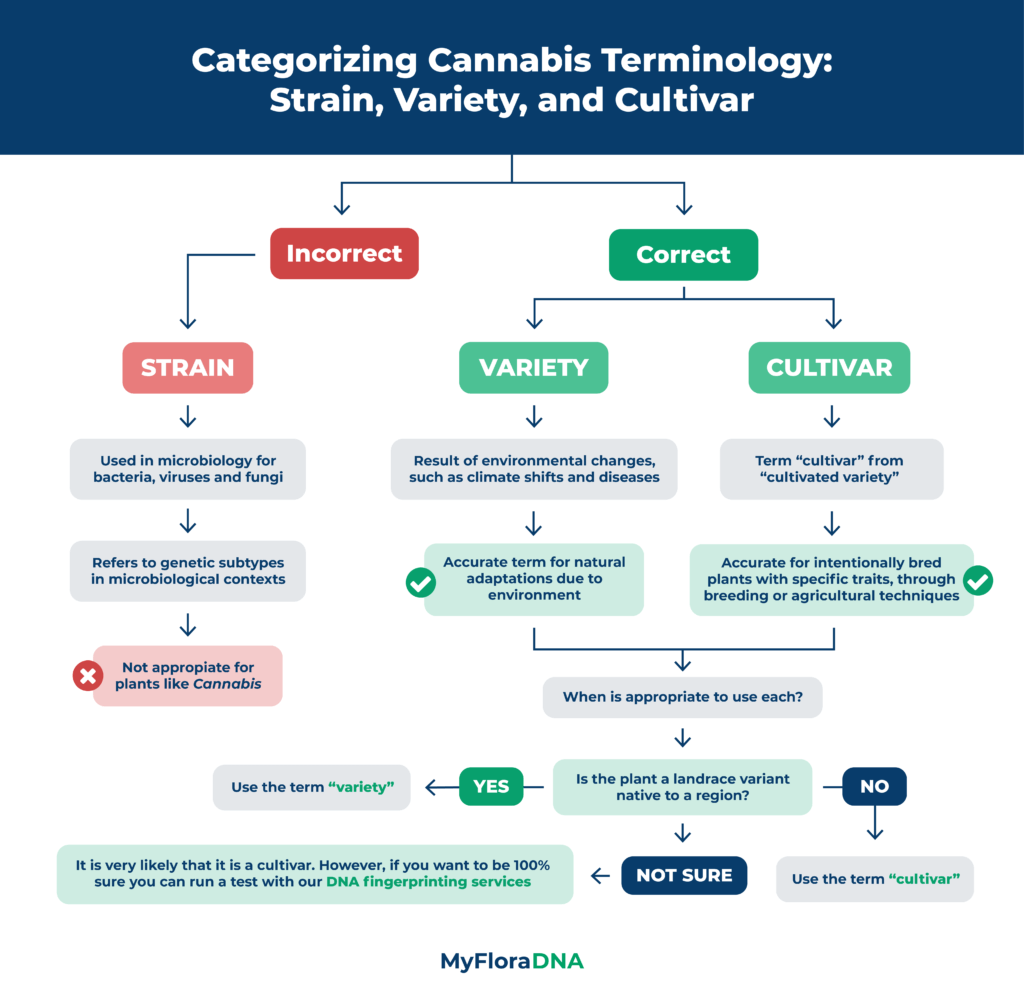
But, how important is it to distinguish between cultivar and variety in Cannabis? In the context of Cannabis, differentiating between cultivars and varieties is essential. Varieties refer to naturally occurring adaptations of the plant due to environmental factors, while cultivars encompass those that have been intentionally bred and developed by humans. For example, a landrace variant found growing naturally in its native region would be considered a variety, whereas a hybrid variant carefully created through crossbreeding different varieties would be classified as a cultivar.
Finally, why should we care about using the correct terminology? Understanding the distinctions between “strain,” “variety,” and “cultivar” is more than just semantic pedantry; it has practical implications for various stakeholders:
- Scientific accuracy → Employing correct terminology helps maintain scientific integrity and clear communication among researchers, botanists, growers, nurseries, and enthusiasts. All must adhere to precise terminology to communicate effectively, exchange knowledge, and avoid misunderstandings.
- Consistency → Consistent use of the terms “variety” and “cultivar” promotes a unified understanding within the cannabis community and the broader horticultural and botanical fields. Standardizing the usage of these terms will aid in streamlining scientific research, regulatory practices, and consumer education within the cannabis industry.
- Preservation of biodiversity → Understanding and distinguishing between natural varieties and cultivated cultivars contribute to the preservation of Cannabis biodiversity.
In summary, although the terms “strain,” “cultivar,” and “variety” are frequently used interchangeably in the cannabis community, they hold distinct meanings. Recognizing the proper usage of each term is essential to enhance clarity and ensure accurate communication. By understanding the differences between these terms, we can better appreciate the diverse and captivating world of cannabis, as well as the diligent efforts invested in developing unique and desirable cultivars.
References
Arévalo, R. A., Bertoncini, E. I., Guirado, N., & Chaila S.. “Los términos cultivar o variedad de caña de azúcar (Saccharum spp.).” REVISTA CHAPINGO SERIE HORTICULTURA, vol. 12, no. 1, 2006, pp.5-9. Redalyc, https://www.redalyc.org/articulo.oa?id=60912102
Dijkshoorn, L., B. M. Ursing, and J. B. Ursing. “Strain, clone and species: comments on three basic concepts of bacteriology.” Journal of medical microbiology 49.5, 2000, p. 397-401. https://doi.org/10.1099/0022-1317-49-5-397
Mostafaei Dehnavi, Mahboubeh, et al. “THC and CBD Fingerprinting of an Elite Cannabis Collection from Iran: Quantifying Diversity to Underpin Future Cannabis Breeding.” Plants, vol. 11, no. 1, 2022, p. 129, https://doi.org/10.3390/plants11010129
Russo, Ethan. “The Case for the Entourage Effect and Conventional Breeding of Clinical Cannabis: No “Strain,” No Gain.” Frontiers in Plant Science, vol. 9, 2019, p. 434025, https://doi.org/10.3389/fpls.2018.01969
Tooker, John, and Frank, Steven. “Genotypically Diverse Cultivar Mixtures for Insect Pest Management and Increased Crop Yields.” Journal of Applied Ecology, vol. 49, no. 5, 2012, pp. 974-985, https://doi.org/10.1111/j.1365-2664.2012.02173.x
Member Blog: Quality Buds, Quality Source. Which Is Better, Seeds or Clones?
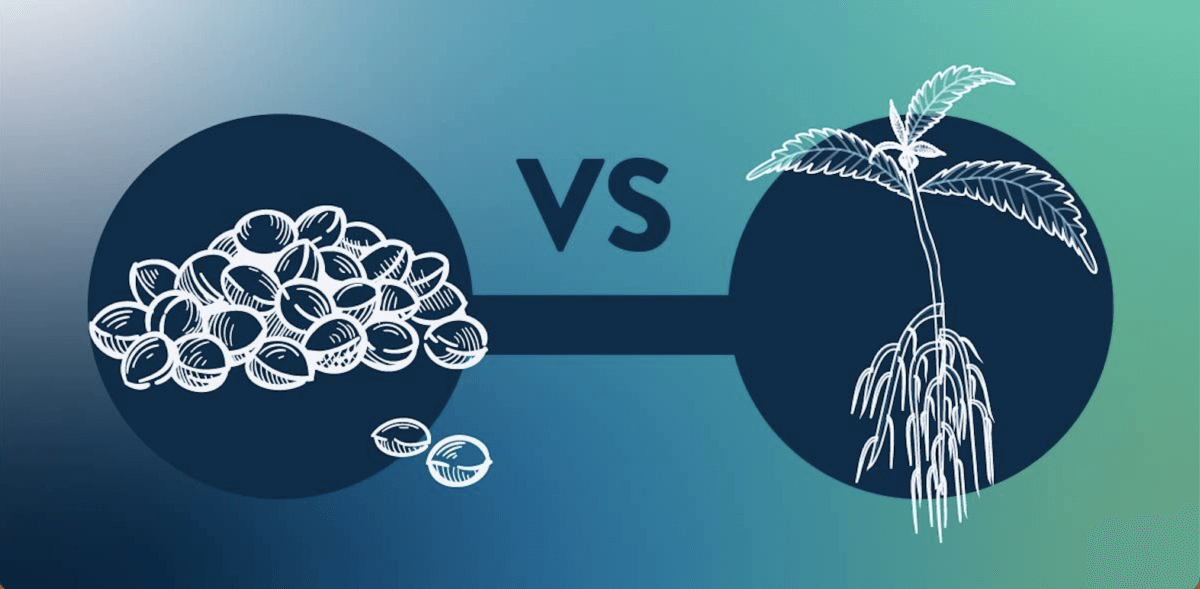
Ask 10 cultivators the best way to grow quality cannabis and you will get ten different answers. From growing medium to nutrients to watering schedule, every cultivator thinks they have dialed in the magic recipe for premium buds. One area where the debate rages is whether it is better to grow from seed or clone. To be fair, both have their pros and cons.
Some prefer to grow from seed because they feel seeds yield a hardier plant, whereas clones are more of a carbon copy of the original; exactly the same but not as vibrant. Thinking about the copy machines of yore, after a few copies, the ink would get lighter and the background less crisp. Some claim that clones provide the same experience. Another benefit to growing from seed is breeding. Since clone mothers are female, all their cuttings are female. If a cultivator wants to cross two cultivars, some males need to be added to the mix. For others, the assured female offspring of the mother plant reduces waste and time, as well as the chance that a rogue male will pollinate the garden. Another benefit of growing from clone is that, because it is a carbon copy of the mother, growers can replicate desired strains for the consumer. And while you can procure seeds from a prize-winning cultivar to grow, there is a chance that, like siblings, the final product will be a bit different than the one before.
For home growers, clones may be preferable because the seedling stage is a very vulnerable one for the little plant. I know that I tried to grow from seed unsuccessfully for a year when I first started until I was gifted an adolescent female. On the other side, since seeds have been deemed a hemp product by the DEA due to containing less than .3% THC, they are easier and safer to ship from place to place, which is a bonus for someone in NY who is excited about a strain from CA. And since clones require a mother room if you want to use the same source plant repeatedly, there is a larger space requirement for growing from clone. In the end, the decision to grow from seed or clone will vary from farm to farm, with some farms, commercial or home grow, choosing to do both. According to the 2023 Home Grow Report from New Frontier Data, 44% report growing from seed, 13% from clone, and 40% use both.
How about you? Are you a licensed cultivator who has opinions on whether it’s best to grow from seed or clone? New Frontier Data is conducting a survey of licensed cultivators in the US and Canada, and we want to hear from you! We are especially interested in cultivators from AZ, CA, CO, FL, MI, OH, OK, British Columbia and Ontario, but all licensed cultivators are welcome to complete it! The survey takes about 10 minutes, is confidential, and if you complete it, you will receive a summary of the results in your state AND be entered to win a $100 Amazon gift card! You can take the survey at: https://hubs.la/Q01_0FFm0
Member Blog: Securing Your Cannabis Venture – Mastering Inspections with Comprehensive Cannabis Insurance
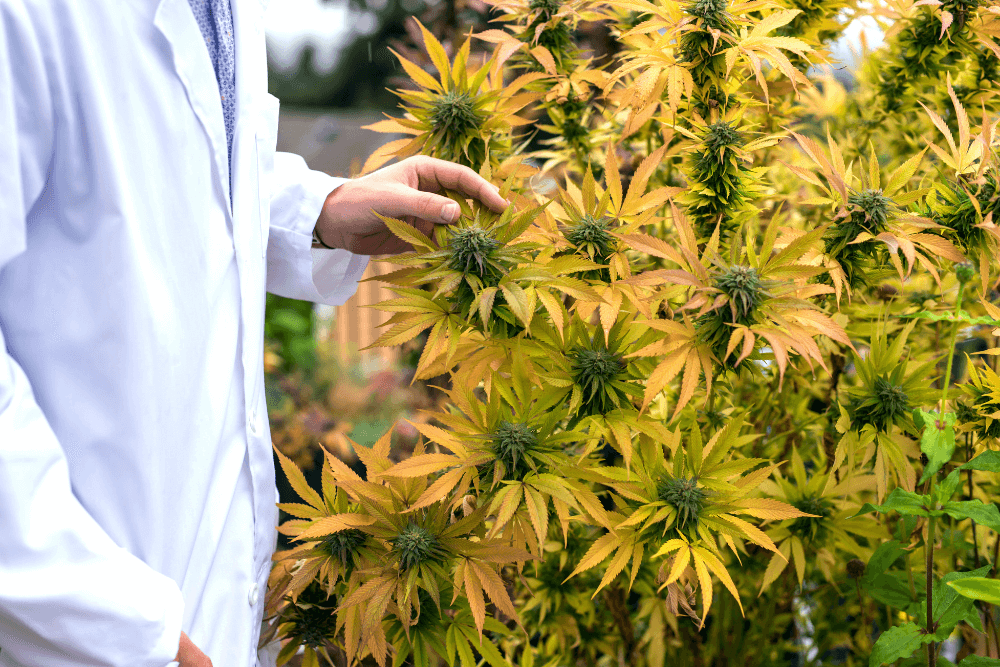
The cannabis industry continues to blaze a trail of growth and innovation, opening numerous opportunities for entrepreneurs and investors. However, this thriving landscape also exposes businesses to unique risks that demand proactive risk management solutions. Insurance plays a pivotal role in safeguarding cannabis ventures from potential losses, making it an essential aspect of responsible business operations. In this blog post, I will explore the critical role of inspections, the challenges they present, and how partnering with a reliable cannabis insurance broker can protect your business interests while mastering the art of inspections.
Understanding the Need for Inspections
The cannabis industry operates under stringent regulations, and inspections are an indispensable component of ensuring compliance. These routine evaluations, carried out by regulatory bodies or insurance carriers, are designed to assess product quality, safety standards, and adherence to legal requirements. While inspections are vital for maintaining high standards within the industry, they also expose businesses to potential vulnerabilities, particularly theft.
The Perils of Theft: Unraveling Insider Threats
As the cannabis industry expands, so does the risk of theft. A concerning issue arises from potential “inside jobs,” where employees or third-party trusted individuals gather sensitive information on-site, posing a significant threat to the operation’s stability. This situation often leads to confusion and concern for clients regarding third-party insurance inspectors who sometimes come on site without communication or vetting.
Clients frequently encounter uncertainty when dealing with these inspectors. They tend to reach out to operators to schedule appointments without confirming the inspector’s affiliation with the insurance carrier or broker. This results in delayed responses, as these calls are often mistaken for telemarketing and disregarded. Unfortunately, this miscommunication can lead to compliance issues with the insurance carrier.
To address this problem, transparent communication between the insurance broker, inspection company, and operator is essential. For example, many clients now ask me to verify the identity of those contacting them before scheduling appointments. I highly recommend this practice to protect clients’ sensitive information.
In this evolving landscape, ensuring security and effective communication is paramount. By taking proactive steps, we can enhance the industry’s growth while safeguarding its integrity.
Transparent Expectations: Building a Solid Foundation
Open and direct communication, coupled with well-defined expectations, serve as the cornerstone for effective inspections within the cannabis industry. My commitment lies in bridging the gap between clients and inspectors, enabling them to familiarize themselves with one another and streamline the scheduling process. A comprehensive comprehension of the inspection procedure, its aims, and the specific areas subject to scrutiny is imperative for businesses. Simultaneously, transparency on the part of insurance carriers regarding inspection protocols and their protective role is crucial for your business’s security.
Embracing a collaborative approach to inspections fosters a strong alliance between businesses and insurers. This synergy guarantees a seamless process that ultimately benefits all stakeholders involved.
Guarding Behind-the-Scenes Details: Protecting Business Operations
In the fiercely competitive cannabis landscape, certain aspects of business operations must be protected with utmost confidentiality. These behind-the-scenes details include proprietary cultivation techniques, security measures, and intricate supply chain arrangements. Recognizing the sensitivity of this information, leading cannabis insurance brokers take extraordinary measures to safeguard such details.
Vetting Inspectors: Fortifying Inspection Security
The integrity of inspection processes begins before any inspector sets foot on your cannabis business premises. Reputable cannabis insurance carriers undertake rigorous vetting of third-party inspection companies to verify their credentials and expertise. This stringent evaluation ensures that inspectors adhere to the highest standards and are committed to protecting your business. In cases where an inspector contacts you directly, it is essential to politely reschedule the inspection and promptly inform your insurance broker.
Aligning Real-Time Risks with Comprehensive Insurance Coverage
Beyond regulatory compliance, inspections serve another vital purpose: assessing real-time risks and aligning them with the insurance coverage outlined in your policy. This strategic alignment ensures that your cannabis business is adequately protected against potential losses. Collaborating with your insurance broker to comprehend the risks inspectors evaluate and their significance empowers you to optimize your risk management strategies. By proactively addressing any coverage gaps, your cannabis insurance policy becomes a reliable safety net, allowing you to navigate the dynamic cannabis industry with confidence.
Addressing Unique Industry Challenges: Tailored Cannabis Insurance Solutions
The cannabis industry operates in a state of constant flux, with evolving regulations and market dynamics presenting ever-changing challenges. These unique complexities demand specialized insurance solutions that cater to the specific needs of cannabis businesses. Leading cannabis insurance providers possess an in-depth understanding of industry intricacies, enabling them to craft policies that safeguard against cannabis-specific risks. From crop damage and product recalls to theft issues, these tailored insurance solutions provide comprehensive coverage, assuring businesses of their resilience in the face of adversity.
Overall, inspections and comprehensive cannabis insurance play instrumental roles in securing your cannabis venture against potential risks and losses. Transparent communication and clear expectations before, during and after inspections build trust and foster collaboration between all stakeholders.
Guarding behind-the-scenes details is of utmost importance, and trusted cannabis brokers go the extra mile to protect your business operations from potential breaches. Vetting inspectors diligently ensures the security of the inspection process, preventing unauthorized access to sensitive information.
By aligning real-time risks with comprehensive insurance coverage, cannabis entrepreneurs gain invaluable peace of mind and the ability to navigate the industry confidently. As you embark on your journey in the dynamic cannabis sector, choose a reputable cannabis insurance broker who understands the intricacies of the industry and can offer tailored solutions to safeguard your business interests.
Remember, mastering inspections and harnessing the power of comprehensive cannabis insurance will be your business’s most potent shield in an ever-changing and promising landscape. Embrace the future of the cannabis industry with confidence, knowing that your venture is secured and protected every step of the way.
For more information, please reach out to Valerie Taylor, Vice President (National Cannabis Practice Leader), Liberty Company Insurance Brokers.
Committee Blog: Navigating the 2023 Cannabis Harvest Season – Balancing Labor Costs, Worker Safety, and Automation
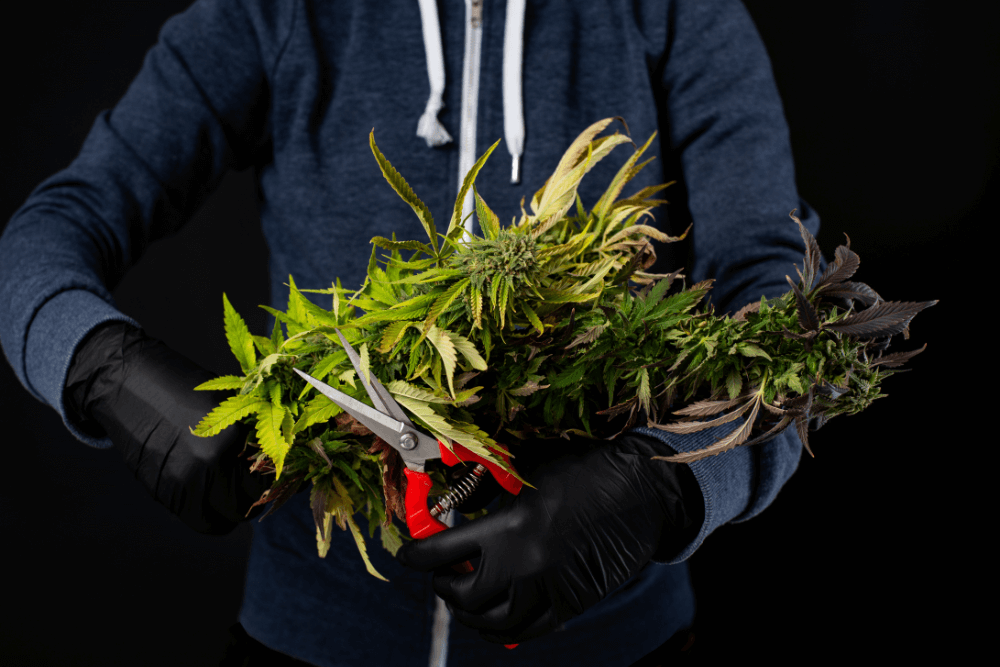
As we enter the Fall cannabis harvest season of 2023, several dynamics impacting human resources in the cannabis industry have shifted considerably. Between escalating labor costs and the imperatives of ensuring safer working conditions, the landscape for cannabis industry employers isn’t what it used to be.
Here are three recommendations to help you navigate workflows this harvest season:
1. Proactive Planning Amidst Rising Labor Costs:
Labor costs in the cannabis industry have seen a sharp surge in recent months. Where we saw hourly rates for harvest workers in years past at $12-$20/hour, this range is now closer to $14-$25/hour, depending on the market. This uptick isn’t just a reflection of rising expectations among industry employers, but also a clearer sense of the safety risks involved, what experienced cannabis harvest workers are willing to work for, and the number of such workers who have left the industry entirely in recent months. For cannabis companies, this necessitates early planning. Human resources departments need to remain agile to adapt to these changes in the labor market.
To address this, a multi-pronged strategy is best. If you’re still finalizing your harvest approach, consider a blend of hiring seasonal talent while also investing in some automation. By leveraging the unique strengths of both seasonal and full-time workers, along with automation, you can tap into hands-on expertise, while enjoying the benefits of flexibility and cost-effectiveness.
2. Prioritizing Worker Safety:
The increasing global temperatures, a distressing trend for many cultivators, has implications for outdoor and greenhouse workers. HR professionals need to be proactive in revising Safety protocols to protect workers from the adverse effects of heat. Regular breaks, shaded areas, hydration stations, and training on recognizing heat-related illnesses are no longer optional. In certain areas, you may want to consider having your crew come in earlier than usual, before the weather heats up, as long as you have adequate lighting in place so the team can work safely.
If you operate in remote locations or places farther from urban centers, it becomes even more crucial to ensure nearby amenities and facilities are optimized for the warmer climate. This includes considering air-conditioned accommodations, cool showers, or providing cooling stations on-site. Keep a list of essential nearby services, and ensure they cater to the needs of workers battling higher temperatures.
In light of respiratory concerns, especially in indoor processing settings, invest in premium Personal Protective Equipment (PPE) for tasks like handling kief, resin, and pre-rolls. This PPE can also be used by workers outdoors when there are some air quality concerns due to fire season. It is not safe for workers to be out when air quality is poor. Check with your Worker’s Compensation provider to see what the threshold is for your policy.
If you’re looking for Work Site Safety or OSHA guidance, please reach out to NCIA’s HR Committee for recommendations.
3. Integrating Automation with the Human Touch:
2023 is undeniably a pivotal year for integrating automation in the harvest process. Advancements in technology offer tools that can help streamline multiple stages of the harvest. While there are certain upfront costs involved, there are also long-term benefits to be had in terms of overall profitability and efficiency. While much of the available machinery has a way to go before being as accurate as an experienced Harvesting Tech or Trimmer, especially for growers in remote areas, where there isn’t a large pool of talent, leaning more on automation could make the difference between harvesting your cannabis at its peak, or not.
You can also look to our related NCIA blog post from 2021 for additional suggestions to help you prepare for the Fall harvest. Navigating the harvest this season will require forward-thinking, investment in a combination of seasonal workers and technology, along with a renewed commitment to worker well-being. As challenges continue to mount in our industry, the companies that adapt and prioritize both efficiency and worker safety will undoubtedly reap the greatest rewards.
Member Blog: How to Avoid the 4 Most Common Payroll Mistakes

To achieve your goals in business, your payroll system must be flawless. It is an aspect in which you must strive for perfection whenever possible. Avoiding payroll mistakes in the cannabis industry is especially crucial due to the highly regulated nature of the industry. Compliance with payroll regulations is essential to avoid legal repercussions and penalties from governing agencies. Additionally, accurate and timely payroll ensures proper compensation for employees, and maintaining precise payroll records promotes transparency and accountability, building trust with employees and stakeholders in an industry where transparency is vital.
It is better to be safe by managing your payroll as thoroughly as possible, if not you would be sorry you didn’t. Most people have most likely made these mistakes and have had minor consequences accompanying them. If these mistakes persist, the business owner often pays dearly for them. These common payroll mistakes have cost some their business.
Having Multiple Records for a Certain Payroll
It pays to have all your payroll information in a single database. This enhances security and ensures that you know where to look for your payroll information. If this has been your practice and your business uses tools like HCM software that helps you manage your employees and other business information, then this shouldn’t be much of a problem.
All you’ll have to do is use that same software to manage and process payroll information. If your business documents are disorganized, be sure to have them all in one place.
Not Updating Needed Information
Ensure that you are not complacent by relying on automated software to do everything. The system is not aware that your employee would be changing addresses therefore such info should be entered manually.
That error could lead to mistakes in filling that employee’s taxes as the bills might arrive at the wrong address. As much as simplifying a process is great, you still need to play your path in getting things done.
It would help you to set timely reminders in the system that should help you avoid the mistake of not keeping up with the latest information.
Weak Security System
Confidential information should remain so. To avoid your system being compromised, you should be using a payroll processing system with strong cybersecurity.
This has got to be the costliest mistake common to payroll processing. Every information concerning your business that is not available on your website and to your customers, is most likely not public information. Private information about your business should remain private.
Information in payroll systems is as sensitive as can be. There’s almost every piece of information you need to know about a person, and as such strict rules should apply to keeping them safe. A weak security measure means a weak business and a weak business means trouble.
Inaccurate or Delayed Tax Payments
In calculating taxes absolute precaution is required. If you are not a tax accountant you are probably not so proficient in this calculation. Your tax accountant (if your business has one) should learn how to adequately use the system to avoid delay or inaccuracy.
Bear in mind that inaccurate tax payment makes your business a tax defaulter. Your business as a taxpayer has the duty of tax calculations assigned to an accountant. Note that taxes ought to be paid within the required time bracket. The systems are programmed to make the tax payments when due.
The human capital management system does not only process payroll information but can also tell when employees qualify for federal or state tax credits.
In Conclusion
To maintain payroll accuracy and timeliness in the cannabis industry, it is crucial to avoid payroll mistakes. By opting for a third-party payroll provider like Tesseon you can benefit from our expertise and ensure that your payroll is consistently accurate and delivered on time, regardless of any industry-specific challenges. The Cannabis industry is both very young and extremely regulated, it is imperative that businesses stay vigilant and proactive to avoid costly mistakes.
Member Blog: The SAFE Banking Act Is Delayed. Again.

Here’s what cannabis businesses can do to make the most out of the current financial landscape.
Companies in the cannabis industry looking to start a relationship with federal banks and credit cards are going to have to wait a little longer. Despite bipartisan support, the Secure and Fair Enforcement (SAFE) Banking Act has stalled in the Senate; caught in minor disagreements, it has missed the opportunity for a vote during the summer session, leaving cannabis-related companies caught in financial limbo. Unfortunately, this isn’t new news: the first version of this bill was introduced to congress 10 years ago.
Politically, the main selling point is that the bill would boost the safety of the cash-heavy industry: Politicians point to an increased number of break-ins at dispensaries as a justification for allowing federal financial institutions to provide services such as bank accounts and credit card transactions to cannabis companies.
An easy political sell, the public safety angle – spelled out in the acronym SAFE – is usually the first (and only) benefit mentioned in the news. Yes, SAFE would allow dispensaries to shift away from cash transactions by permitting credit card companies to service businesses that produce, manufacture, distribute and sell cannabis, despite the fact it is a schedule 1 controlled substance.
But beyond preventing robberies, the bill would start to level the economic playing field for this growing industry that already faces an extremely high rate of federal taxation, on top of other disadvantages, such as higher transaction and banking costs that lead to pricing pressure – and make it tougher to compete with the illicit market.
Because of cannabis’ schedule 1 status, nationwide banks are not allowed to provide any services whatsoever to cannabis-related businesses. Even though the businesses are legal at the state level, national banks operate under a federal charter that prohibits such relationships – not just with dispensaries, anyone who does business with the cannabis industry – web designers, lawyers, marketers, etc.
(I learned that the hard way when, in the early days of working as a virtual CFO for cannabis companies, I had all of my Bank of America accounts – personal and business – frozen and shut down abruptly.)
Since federal banks cannot provide small business loans or even issue checking or savings accounts, cannabis-related businesses are limited to small banks (i.e. credit unions, state banks). They face higher borrowing costs, and receive lower interest rates, cutting them off from many of the privileges other industries enjoy. Best financial practices – like securing a line of credit or keeping operating cash in an interest-bearing account – may seem out of reach.
For cannabis-related companies that had been impatient to take advantage of this new legislation, the news is frustrating to say the least.
But there are lots of ways retailers can work within the current financial landscape. Here’s what I recommend.
- Seek an interest-bearing account – The smaller banks and credit unions servicing the cannabis industry typically do not offer these clients interest-bearing products. However, it is possible to find interest-bearing accounts for operating cash, for example through the fintech company Safe Harbor Financial, with rates starting around 1.5%.
- Secure a line of credit – With loans hard to come by, cannabis companies often feel as though they have to access capital from private investors, forcing them to give up equity. But seeking non-dilutive funding is possible – and recommended – once you’ve established your target operating cash balance of 10-30% of annual revenue.
Many cannabis friendly banks will offer unsecured lines of credit at rates of base rate +4% – but generally only in limited license states.
Note: although rates can be competitive in some cases, the amounts tend to be lower. However, since these facilities are often based on an amount per tax ID, multiple entities could each carry their own line of credit and increase total borrowing capacity.
- Facilitate compliant debit sales – We know cash-only can drive down retail sales and increase risk of theft or employee mismanagement. With credit cards unavailable, two popular, but non-compliant, solutions have been cashless ATMs and Mastercard and Visa debit cards. While cashless ATMs experienced a crackdown last December, the latest news suggests that Mastercard is also cutting off this popular work-around.
Rather than get caught up in the headlines, adopt compliant pin-based debit cards, through products such as Aeropay. Unlike traditional debit card transactions, customers will have a fee, and they’ll also have to set up a specific app to gain access, but as all other cashless options appear to be erased, the benefits outweigh the costs, especially for regulars.
Just make sure you’ve got a point of sale (POS) system with flexibility in terms of their API (application programming interface) – for example Flowhub – so that you can integrate the pin-based debit card payment method.
- Don’t pay monthly banking fees – While most banking institutions charge account fees to cannabis businesses, with a little research you can find some that waive those fees, for example Main Street Bank and Safe Harbor Financial.
- Keep deposits safe – Although the dust has settled since the collapse of Silicon Valley Bank, cannabis businesses should still keep an eye on managing their banking risk. Since programs like CDARS and ICS are not available to the industry, we recommend cannabis operators keep deposits at multiple banks to keep the highest possible FDIC insured balance.
Despite these financial obstacles and policy roadblocks, the cannabis industry continues to grow, year after year. Accessible banking products are out there – and as we wait for more federal legislative progress, it can be well worth the investment to do a little research to find out which ones best meet your businesses’ needs.
Member Blog: 5 Types of Business Insurance You Should Consider

As the cannabis industry continues to rapidly expand and evolve, entrepreneurs need to be proactive in safeguarding their businesses from potential risks. Insurance is crucial for any business, and the cannabis sector is no exception. In this article, we will explore five important types of business insurance specifically tailored to the needs of cannabis entrepreneurs. By understanding these essential policies, cannabis industry professionals can make informed decisions to protect their investments and future-proof their ventures.
General Liability Insurance
General liability insurance covers the cost of any injury or damage caused by your business. This includes injuries on your premises and injuries to someone while using your products or services. It also covers you if someone is injured while on your property, even if they’re not part of an organized event or program (like a birthday party). General liability insurance will also cover the cost of any lawsuits filed against you for negligence or breach of contract arising out of the above scenarios.
Professional Liability Insurance (Also Known As Errors And Omissions)
Professional liability insurance, also known as errors and omissions insurance, protects you from lawsuits if a client feels you have made an error in your work. This can be anything from a client claiming that you didn’t perform according to the contract terms or did not fulfill their expectations.
This coverage differs from general liability protection in that it only covers claims against professional services like accounting or legal services. If you own a business where your products or services could physically injure customers, you also need general liability coverage (more on this later).
The good news is that most businesses need both types of policies: professional liability for the expertise required for running their business and general liability for protecting themselves against bodily injury incurred by customers using their products/services.
Business Interruption Insurance
A business interruption policy provides coverage for losses that result from the sudden, unforeseen loss of use or operation of your business. For example, if you’re forced to close your doors because a fire destroyed your building, this policy will pay back some of the revenue you lost during that period. Business interruption insurance can be purchased as part of a multi-line or a stand-alone policy.
Workers’ Compensation
The next type of insurance to consider is workers’ compensation insurance. This form of insurance covers the cost of medical expenses and lost wages for an employee who has been injured on the job. In all states, workers’ compensation policies are required by law, but you may want to add additional coverage for your business if there is a high risk of injury among your employees. Your premiums will be higher if you have a larger number of workers or more dangerous jobs than others in your area, so it makes sense to review this kind of coverage before purchasing it.
Employment Practices Liability (EPL) Insurance
Employment Practices Liability (EPL) insurance can be a lifesaver for small businesses, especially when there are multiple employees.
EPL insurance protects your business from sexual harassment, discrimination, and wrongful termination claims. It also provides coverage for defending these types of claims against you.
If you’re doing business in certain industries, EPL policies are often required by law or rely on government contracts to run your business. A few examples include healthcare providers, educational institutions, restaurants, and hotels—though it varies by state, so check with your insurance agent before purchasing a policy.
Conclusion
The bottom line is that you should consider your business insurance needs carefully and ensure adequate coverage. If you’re unsure about what type of insurance to get or how much coverage is enough for your business, please speak with an agent or broker who can help guide you through these decisions.




































 Strain
Strain





